

Answ er the ‘BURNING’ ques tion with fire pre v ention




Answ er the ‘BURNING’ ques tion with fire pre v ention

In the event of fire, are you certain that your business, people, plant and investment are protected ?
AST offers a range of cutting edge Fire Suppression Technology to protect what you value the most!

We work with clients, system integrators and engineers to ensure that fire systems are properly designed and operational in order to detect and eliminate fire before it can cause destruction. CONTACT





+ 27 (0) 11 949 1157


We drive inclusive growth and transformation by financing property entrepreneurs in their purchase and refurbishment of rental properties, with a focus on affordable rental housing, through:
Entrepreneurial growth
• SME development with a housing outcome
• Access to finance – any language, any level
• Training and mentoring clients every step of the way
Local economic development
• Support for the influx of talent and increased diversity in our inner cities
• Stimulate local economic and social development
• Inclusive economic growth happens locally
Job creation and skills development
During construction
Urban regeneration and densification
• Finance repurposing and new build in inner cities
• Precincts where in neighbourhoods are regenerated
Fiscal impact for local government
• Increasing inner city property values
• Increased & compliant utilities & rates base
• Allows government to focus on productive infrastructure investment
Urban land reform
• Empowerment finance model
• Inclusion changes ownership.
TUHF21 achieves real and evidence-based development impact, by backing people with local knowledge and networks to deliver practical urban development and affordable housing solutions.

We incubate financial solutions that have business continuity and are sustainable, developing solutions until they are ready to stand alone, always looking for new, innovative ways to provide real development impact. Building on the 18-year success story of TUHF, our focus now is on three pillars to harness fresh opportunities:
Managing and growing the Intuthuko Equity Fund, uMaStandi township housing development product, and others such as our Sustainable Bond Framework for Green and Sustainable Bonds.
Developing new solutions based on relevant and practical research.
Providing impact tracking and reporting services for the group to ensure the development impact activities continue in a financially sound and highly governed manner.








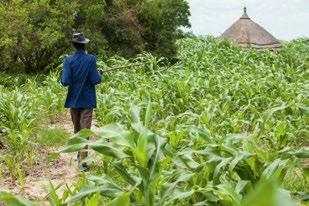

FROM
PUBLISHER
Donovan Abrahams
EDITOR
Ashley van Schalkwyk ashley@avengmedia.co.za

CHIEF SUB-EDITOR Tania Griffin tania@avengmedia.co.za
DESIGN AND LAYOUT
Stacey Storbeck Nel (Indio Graphic Design) indiodesign@mweb.co.za
T
So why am I telling you this seemingly insignificant story? It’s a cautionary tale for those looking to start their own business. In these tough economic times, more and more people are going the entrepreneurial route. To these budding businesspeople I say good luck, but I also advise you to do the basics right. Get your foundation in place, even for just a micro-business you run from your home. Please don’t cut corners. Comply with legislation and get your ducks in a row—or you could see all your efforts come to naught.
When I heard about the young lad’s dilemma, I recalled a conversation I had some years ago with Raymond Ackerman. Asking for some business advice, the Pick n Pay founder imparted the following bit of knowledge (and I paraphrase): When starting a business, the first thing you do is hire a lawyer and an accountant, and don’t argue about how much they charge.
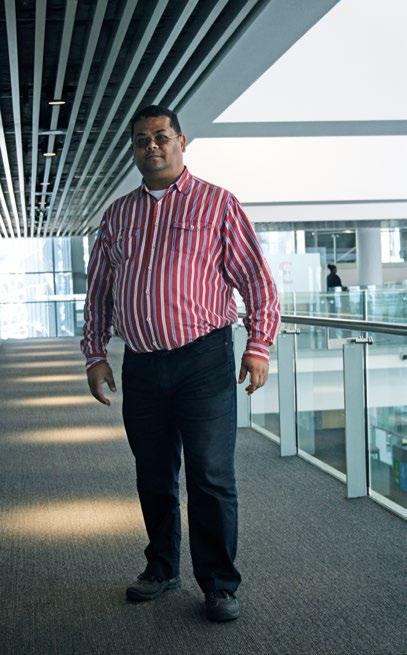
Admittedly, not every startup will have the finances to hire a lawyer or accountant at inception. A more affordable way of ensuring compliance is to contact the Companies and Intellectual Property Commission (CIPC). There are offices around South Africa (except in the Eastern Cape), but it can also be contacted on 086 100 2472. Alternatively, check the website www.cipc.co.za.
So stay compliant. And peruse our publication for more valuable business lessons and opportunities in Africa.

Ashley van Schalkwyk
Rashieda Wyngaardt





















































































































































































































































































23 to 25 August
Online
www.africanconstructionexpo.com
The African Construction & Totally Concrete Expo is a significant contributor to the economic growth, recovery and transformation within southern Africa’s construction industry and places a special focus on buyer and seller engagements. It offers five technical talks, bringing like-minded people together to learn and share experiences about the built industry.
23 to 25 August
Online
www.africanconstructionexpo.com
The 4th annual African Smart Cities Summit (at the African Construction Expo) will explore major trends, celebrate Africa’s progress, debate challenges and opportunities and discover the innovations set to advance African cities. The summit will facilitate positive growth through strategic thought leadership and inspiring case studies. The inclusion of the Smart Cities Pavilion on the exhibition floor showcases how technology and innovative solutions can transform African cities.
24 & 25 August
Online
www.terrapinn.com
Power & Electricity World Africa is the definitive virtual event: unique and forward-thinking, combining new technology, efficiency, new thinking and best practice in the industry. Year on year, Power & Electricity World Africa provides partners with access to African utility, government and IPP decision makers who traditionally are difficult to reach. This year’s virtual event will be no different, delivering on how market players can capitalise on business opportunities across the continent.
25 & 26 August
Online
africabanksummit.com
With the emergence of neo banks in the region, the gap between the banked and unbanked segment is further narrowing through their efforts. Neo banks are challenging mainstream banks
with exceptional customer support services and turnaround time in service delivery. Gathering the crème de la crème of West Africa’s fintech sector to address solutions around transforming the region’s digital financial services roadmap, the 5th Africa Bank 4.0 Summit will focus on enhancing the coverage of access to finance across the region.
14 & 15 September
Sarit Expo Centre, Nairobi, Kenya www.africatechsummit.com
Africa Tech Summit Nairobi connects tech leaders from the African ecosystem and international players under one roof. Network with key stakeholders including tech corporates, mobile operators, fintechs, DeFi & crypto ventures, investors, leading startups, regulators and industry stakeholders driving business and investment forward.
21 to 23 September
Cape Town, South Africa and online innovationsummit.co.za
The SA Innovation Summit is the largest startup event in Africa. It provides various platforms for developing and showcasing African innovation, as well as facilitating thought leadership. It brings together top entrepreneurs, investors, corporates, policymakers and thought leaders to support startups and inspire sustained economic growth across Africa.
28 to 30 September Online www.theafricaceoforum.com
The COVID-19 crisis rapidly accelerated numerous trends already in the making, such as the diversification of global value chains, the rise of Sino-American rivalry, the elevation of climate change as a priority, and the fast-tracking of digitalisation. New economic realities are emerging and putting the brakes on a 70-year economic cycle dominated by globalisation, industrialisation and fossil fuels—and forcing us to rethink the strategies of African economies and businesses alike. The Africa CEO Forum, the largest gathering of the African private sector, provides a platform where the continent’s most influential decision-makers can make their voices heard on the new world before us. It’s also a prime opportunity to discuss how African businesses can best adapt to and stay competitive in an everevolving environment.






SAIPA members aim to provide the highest level of expertise and service to clients and are bound by the Institute’s Professional Conduct Standards and Ethical Pledge. They also act as trusted business advisors, assisting and driving businesses to not only survive but thrive.



As Bigen greets one remarkable visionary and welcomes another, it will open yet another chapter of ongoing success and build on the company’s legacy of satisfied clients across Africa
Bigen, a leading African infrastructure development group of companies, has recently announced the retirement of current CEO Dr Snowy Khoza, who has been at the helm since 1 October 2010— holding the distinct roles as the group CEO and executive chairperson of Bigen Africa Group Holdings. Dr Khoza will be going on a well-deserved and planned retirement on 31 December 2021 and will be handing over the baton to Mr Luthando Vutula as CEO incumbent on 1 August, providing ample time to complete a proper handover before he fully takes over the helm on 1 October 2021.
Internationally acclaimed as an astute business professional and the recipient of numerous prestigious local and international awards, including being named as one of Africa’s most influential women in 2020, Dr Khoza was the first female in South Africa to lead a major infrastructure development company. Over the past 11 years, Dr Khoza was particularly successful in spearheading Bigen’s repositioning from a conventional South African civil engineering firm, to an African infrastructure development leader in deliberate pursuit of improving livelihoods for the people of Africa.
Mr Kelepile Dintwe, non-executive chair of the Bigen Board, pronounced Dr Khoza as a dynamic and inspiring visionary with remarkable leadership acumen, and in a recent public announcement said: “The immeasurable business value created by Dr
Khoza during her tenure at Bigen can never be overstated, which spans a successful growth phase of the business to navigating the global economic shakedowns within the built and environment sector seen over the past three years, and recently the obvious impacts of the COVID-19 pandemic. On behalf of the Bigen Board and shareholders of the company, I would like to thank Dr Khoza for her years of dedication, passion, commitment with integrity and vision to bring the company where it is today.”
Dr Khoza described her tenure with the Bigen Group as a humbling journey of reaching new pinnacles of success and of immense fulfilment, especially considering the remarkable difference Bigen has made to the livelihoods of millions living on the African continent: “There are no words that can express how sincerely grateful I am for the privilege and honour to have been part of the Bigen family for the past 11 years. Together with an exceptional board of directors, visionary leaders, shareholders, loyal clients and steadfast employees, we have reinvented and strengthened Bigen to the point where we are now regarded as a leading champion of the infrastructure development impact agenda in Africa. Together, we have not only improved the quality of life of millions of people across the African continent, but also earned a solid reputation as partner of choice in helping the continent achieve its Sustainable Development Goals (SDGs) by 2030.”
“Starting a leadership transition process over the next two months brings to a close a remarkable era of growth, transformation and sustainable business reinforcement under the admirable leadership of Dr Khoza, and opens the doors to the continued shaping of the Group into a new growth trajectory,” said Dintwe. “Mr Vutula is a highly revered and successful business leader with extensive years of experience in similar markets to Bigen, and we look forward to him building on the solid foundation and momentum achieved by the outgoing CEO and the Bigen leadership team.”
Previously the CEO of Ubank, Vutula hails from an impressive business background where he has held senior executive and non-executive positions in major South African development, management and finance companies, contributing at main board level to the setting and implementing of strategic policies. He brings to the table years of experience, business acumen and leadership skills honed from leading high-performance teams and extensive exposure to infrastructure development on a national and international level. Having established networks in all tiers of the South African Government, Vutula is involved with various multinational agencies and diplomatic circles in Africa, Scandinavia and North America, as well as donor agencies
such as The United States Agency for International Development and the European Union.
Before accepting the position as CEO of Bigen, Vutula held the positions of CEO at well-established financial services provider Ubank; Head of Sectors at ABSA Retail and Business Bank; managing executive at ABSA Home Loans, and managing director of ABSA DEVCO. Prior to joining ABSA, he served on the executive level at the National Housing Finance Corporation, where he was responsible for a number of portfolios. He has chaired several boards in both the private and public sectors.
Regarded as a thought leader and trendsetter, Vutula is no stranger to the media. Known and widely respected at key decision-making levels in the SA housing industry, financial sector, and in the public sector at national, provincial and local levels, he is often quoted as an expert on issues such as inner-city regeneration and social housing.
Among numerous other academic achievements, Vutula holds a Master’s Degree in Development Finance from the University of Stellenbosch, a BA Honours Degree in Business Administration from the University of Stellenbosch, and a Bachelor’s Degree in Economics and Accounting from the University of Botswana.
“I am honoured to follow in the impressive footsteps of my predecessor, Dr Snowy Khoza,” said Vutula. “During her dynamic tenure of eight years as CEO and three years as executive chair of Bigen, she accomplished remarkable feats and developed Bigen from being a South African-based consulting engineering firm, to a driver of socio-economic change across Africa through innovative, solutions-focused engineering, advisory and infrastructure development. I am excited to continue her legacy, and while some things may change, certain things will always be prioritised in our decision-making: our people, our continent, creating wealth for our stakeholders and leaving a legacy we are proud of.”
The Bigen Group has, since its inception
The development and implementation of a 360km strategic water transfer system for the Botswana government has resulted in an award for infrastructure development company Bigen, and improvements to socio-economic conditions in the capital city of Gaborone.
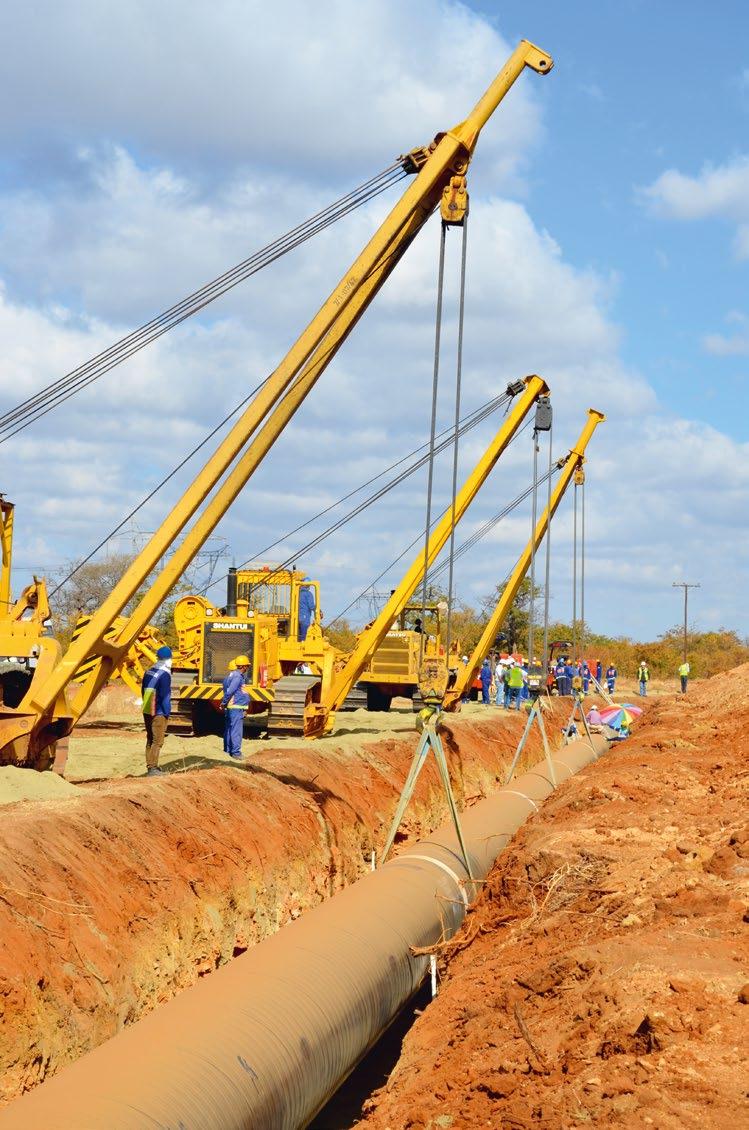
50 years ago, earned a solid reputation as an innovative, solutions-focused engineering and infrastructure development partner and employer of choice, invested in the future of Africa. Powering social and economic growth by developing sustainable infrastructure across Africa, the Bigen Group is an influential contributor to socio-economic development across Africa, creating and sharing wealth for all its stakeholders. Throughout its journey of half-a-century, the Group has grown and transformed from a traditional engineering consultancy operating from one office in Polokwane, to an engineering firm operating
from eight regional offices in South Africa, to a truly African infrastructure development group of companies with its headquarters based in Mauritius and South Africa and with office presence in Kenya, Ghana, Botswana, Mozambique, Namibia and Zambia.
Over the past five decades, the Bigen Group has kept pace with the fast-growing infrastructure development needs of the continent and has evolved into a powerful change-maker in the agricultural, water and sanitation, real estate, transportation, energy, health, and development advisory sectors—responding to the continent’s
Through its involvement with many health projects such as the Konza Hospital in Kenya, Women & Children’s Hospital in Lesotho, Kampala Hospital in Uganda and the Riverside Private Hospital in Francistown, Botswana, the Group has assisted in bringing improved healthcare infrastructure to 1.2 million people in one year alone.

At the end of July 2020, 62 SIPs were gazetted, six of which involve Bigen, namely:
• Phase 2A of the Mokolo Crocodile River (West) augmentation project, Limpopo;
• Rehabilitation of the Vaalharts-Taung irrigation scheme, Northern Cape and North West;
• Berg River Voëlvlei augmentation scheme, Western Cape;
• Phase 2 of the Lesotho Highlands water project, Gauteng;
• Lufhereng development, Gauteng; and
• Vista Park 2 and 3, Free State.
socio-economic development needs with a blend of financial, technical, environmental, development impact and advisory and institutional services.
As an African group, working in Africa for the people of Africa, the Bigen Group has become extremely adept in achieving a keen balance between profitability and its passion for beneficiating community well-being aligned with helping the continent achieve its SDGs by 2030. Achieving these goals has become especially critical since the outbreak of the COVID19 pandemic which, according to a World Bank Report, has forced up to 40 million people living in Africa into extreme poverty. This is severely impacting the achievement of the SDGs, of which SDG1 (no poverty by 2030) is suffering the largest setback.
Classified as an essential service, the Group was able to operate throughout the different levels of lockdown and its related restrictions, and continued to support the government in its quest to combat this disease by supplying drinkable and running water critical for impoverished communities to comply with national directives, including hygiene and hand washing. The upgrading of healthcare facilities and erection of temporary ones to accommodate COVID-19 patients were other important projects Bigen was able to undertake for,
inter alia, its Department of Heath clients. The Group also managed to donate thousands of masks and hand sanitisers to impoverished communities—and with development impact always top of mind, its projects during the COVID season persistently improved the quality of life of thousands of people.
South Africa’s post-lockdown economic recovery plan, as announced by President Cyril Ramaphosa on 15 October 2020, is a four-pronged approach that includes a particularly strong focus on infrastructure development to boost investment and growth. Envisaged is a R1-trillion investment with pledges amounting to R664 billion, with R170 billion in capital expenditure already committed. For all of Bigen’s directorates, this strategy holds much business potential in the countries of the African Continental Free Trade Area, which has been launched this year. The president reported in his New Year’s message that important progress had been made in vital economic reforms that would ensure affordable energy, cheaper and faster broadband and more competitive railways and ports of entry. Bigen is already involved, by way of engagement on specific projects, in the South African Strategic Integrated Projects (SIP) programme of the Department of Public Works and Infrastructure under the presidential Infrastructure Co-ordinating Commission Council.
Bigen, with its goal of maximising infrastructure development in Africa to boost socio-economic development outcomes, is regarded as a partner of choice for governments seeking to reach their SDGs. This is based on the Group’s ‘one-stop’ capability, strong social and environmental conscience, and core vision to improve quality of life through infrastructure that provides sustainable social and economic benefits for countries, regions and communities. The Group’s philosophy is embodied in its creed of “doing good while doing business”, which is consistently evident in the socio-economic impacts derived from every project the Group undertakes. Through all its projects, the Group endeavours to increase access to services, reduce poverty, build capacity, and generate opportunities for increased economic participation and employment.
Interconnectedness and accessibility are key economic drivers, and Bigen plays a key role in ensuring these through the development of roads, ports and communication network infrastructure, as well as the provision of services and facilities such as schools, hospitals and clinics. During the past few years alone, the Group has improved the lives of millions of people through its involvement in:
• The development and delivery of an excess of 320 000 housing opportunities across the continent;
• The delivery of various energy solutions to over 400 000 households across the continent;
• The provision of access to economic opportunities, movement of goods and services through roads, rail and bridge projects over 4 500km;
• The provision of clean drinking water and human dignity, employing formalised sanitation solutions to around 600 000 households; and
• More than 42 000 schools projects in South Africa alone.
In addition, Bigen continues to support national economies through expanding and improving port terminals; providing telecommunication services and completing feasibility studies such as for mines and hospitals.
Bigen is often described as “engineers with a conscience”, producing top-quality projects on brief, on time, within budget and with development impact always top of mind. It is, therefore, no surprise that the Group has been appointed on many state-of-the-art projects throughout the years, notably the award-winning NorthSouth Carrier Water Transfer Scheme in Botswana, the award-winning Klarinet Ministerial Integrated Housing Project and the prime Val de Vie Estate projects in South Africa.
More recently, the Group was also appointed as civil & electrical engineers on
the world-class Tambo Springs Logistics Gateway project. Strategically situated on the southern periphery of Ekurhuleni near the OR Tambo International Airport and several major road networks, the facility is expected to unlock economic growth and job creation of more than 8 000 direct jobs in the province. Seamlessly integrating road, rail, air and sea transportation of freight, it is a key platform for the manufacturing, distribution, warehousing and shipping industries, and will likely double the province’s freight capacity.
Bigen boasts a rich legacy of innovative projects in more than 19 African countries, and its epic journey of providing costeffective infrastructure development solutions toward building sustainable communities is validated by its projects to the value of more than US$14 billion over the past 10 years alone.
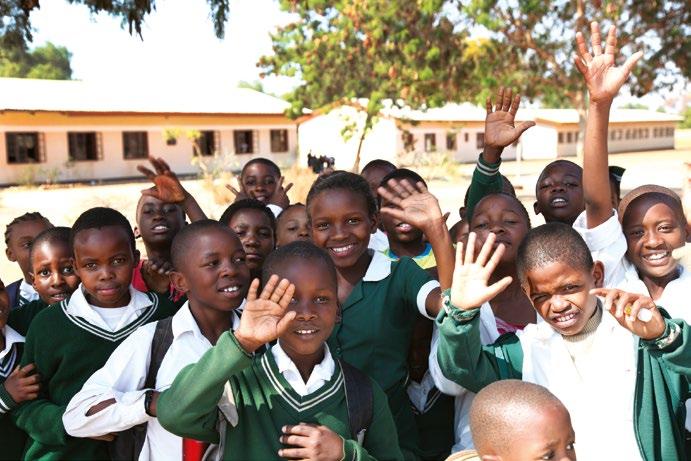
The Group is also making a remarkable difference in providing improved access to quality healthcare for thousands of people across the continent. Through its involvement with many health projects such as the Konza Hospital in Kenya, Women & Children’s Hospital in Lesotho, Kampala Hospital in Uganda and the Riverside Private Hospital in Francistown, Botswana, the Group has assisted in bringing improved healthcare infrastructure
to 1.2 million people in one year alone.
Some of Bigen’s other current projects transforming lives and boosting economies on the continent of Africa include:
• The development of 30 000 housing units for the Ghanaian armed forces in Ghana;
• The North South Carrier Pump Station and Associated Works project in Botswana to increase water transfer capacity on the North South Carrier Water Pipeline;
• The Pokuase Interchange Project in Ghana to alleviate traffic congestion; and
• The Walvis Bay to Kranzberg Railway Upgrade project in the Erongo region in line with Namibia’s goal of developing a regional transportation hub linking the country with southern Africa.
“There is enormous opportunity for the Bigen Group, to not only rebuild Africa in the aftermath of COVID-19 and the recent South African civil unrest and plundering, but also to assist Africa in reaching its 2030 Sustainable Development Goals. Although we are filled with mixed emotions having to say goodbye to the iconic Dr Snowy Khoza as CEO, we are also looking forward to Mr Vutula joining our family and helping us to achieve continued success,” said Mr Dintwe. “Because of Dr Khoza’s drive and distinguished ability of turning Bigen into an infrastructure development leader, we are ready to take on the future with unstoppable enthusiasm and vigour. We are confident that as we say goodbye to one remarkable visionary and welcome another, we will open yet another chapter of ongoing success and build on our legacy of satisfied clients across Africa.” ◆
Bigen Group
Tel : +27 (0)12 842 8700 Fax: +27 (0) 12 843 9000/9001 E-mail: pretoria@bigengroup.com www.bigengroup.com
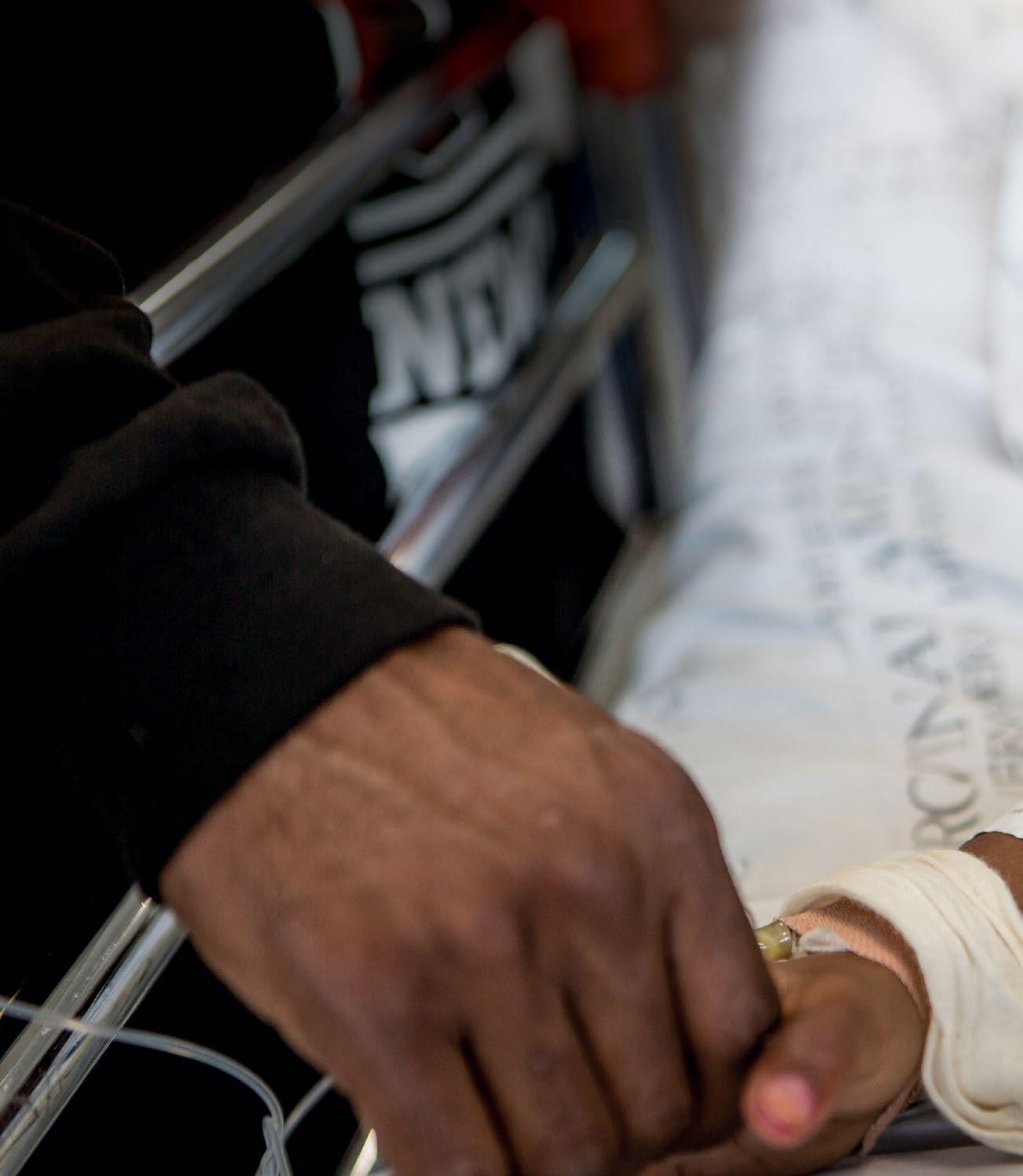



With digital transformation a top priority on the corporate agenda as companies identify new ways to grow their business, cyberattackers remain very active. Although Africa is not considered a focus area for the more sophisticated types of cybercriminal activity such as targeted attacks or advanced persistent threats (APTs), the continent is certainly not immune to these or other types of cyber risks.
Kaspersky research shows that in 2020, worldwide, about 10% of computers experienced at least one malware attack. In some African countries, the figure was only slightly under the global 10% average— making the African region comparable to that of North America or Europe in terms of cyberattacks. On some parts of the continent, in countries like Liberia, Tunisia, Algeria and Morocco as examples, Kaspersky has seen a slightly higher rate, while other parts show a lower rate: a 5% or 6% average. For the first quarter of 2021, the figures were only slightly lower than 10%, both in relative and absolute terms.
Says David Emm, principal security researcher at Kaspersky: “Generally speaking, and based on our research, Africa has the same hit rate as we would see for other parts of the globe when it comes to cyberattacks and activity. This only emphasises that the cyber threat landscape truly does incorporate the whole globe where no continent or country is free of this growing danger and where all consumers, businesses and industries alike need to pay attention to effective cybersecurity measures—and especially during the current pandemic and resultant turbulent times.”
In South Africa, Kenya and Nigeria, Kaspersky’s research has identified the top malware families as ransomware, financial/ banking trojans, and crypto-miner malware. When comparing Q1 2021 with Q2 2021,
Kaspersky saw a 24% increase in ransomware in Q2 2021 in South Africa, as well as an increase of 14% in crypto-miner malware. In Kenya and Nigeria, Kaspersky saw a large increase in financial/banking trojans in Q2 2021 when compared to the figures for Q1 2021: a 59% increase in Kenya and a 32% increase in Nigeria.
While on a technical level, not much has changed when it comes to cyberattacks; but the pandemic presents a persistent topic in which the world has a vested interest. So, it offers a wealth of opportunities for cybercriminals to use malware to attack. Everything from the daily numbers and lockdown restrictions to vaccinations, hackers are leveraging on every aspect of the current situation to compromise systems.
“While the bulk of attacks are still speculative and randomly targeting individuals and businesses, there is a shift happening with the increase of APTs and more strategically targeted based attacks. These use continuous, clandestine and sophisticated hacking techniques to gain access to a system and remain inside for a prolonged period, with potentially destructive consequences. Because of the time and effort required to perpetrate such an attack, these are often levelled at high-value targets such as nation states and large businesses,” adds Emm.
As the cyberthreat landscape evolves, the nature of malware is changing. “Take ransomware,” says Emm. “In the beginning it was very random, targeting as many people as possible, hoping for a relatively small amount of money paid in ransom. During the past five years, there has been a shift with a decline in the number of ransomware families being developed as well as an overall global decline in attacks. However, attackers are now focusing on specific companies and individuals where they can get the maximum benefit. The new
approach of ransomware is to expose data, negatively impacting the reputation of a company. To this effect, financial crime has become more sophisticated and organised.”
The financial services sector remains a top targeted industry in Africa when it comes to cybercriminal activity and such cyberthreats—not surprising when one considers the digital-first approach this sector continues to take, driven by the needs and expectations of its customers.
“It is relatively easy for a hacker to target an individual and capture passcodes, one-time passwords, and install malware on their computers to get financial information. This is expanding to financial institutions, given the sheer number of new entrants in the market emerging. For hackers, online or cyber fraud offers direct monetisation of an attack and gives them access to money as quickly as possible,” adds Emm.
Financial-based malware and cyberattacks are also becoming more targeted, complicated and difficult to prevent, and with digital transformation progressing at a rapid rate within such a sector, there is no shortage of attack surfaces for cybercriminals to exploit.
“In a world where cybercrime remains rife and is only fuelled by aspects like the pandemic, there is never a moment one should not consider the implications of a cyberattack, especially as the cyberthreat landscape evolves and become even more targeted and sophisticated than it was a mere few years ago. Cybercrime is a business; consumers and companies alike must remain vigilant against an increasing attack surface. Not only does this entail a more focused cyber training approach for staff within an organisation but also using the latest technologies that feature AI and machine learning for accurate and proactive protection and prevention in real-time,” concludes Emm. ◆
With Sage Intacct, you can expand your reach and improve efficiency during financial close
With Sage Intacct’s cloud software, you can speed up your financial close by tracking inventory and automating processes. Intacct allows businesses to reduce their work hours by simply syncing all the expense reports in minutes without having to view them. Using intacct’s planner feature, these reports can be organised into a budget and easily handed in at the end of the month so that
robotic process automation, as well as real-time financial reporting systems. “At OS Holdings, your business’ success is our business,” says Nomsa Nteleko, the company’s co-founder and CEO.

“While businesses are still defining what the ‘new norm’ is, business owners must make operational changes, now, that will future-proof their business—which is why products such as Sage Intacct are a vital element of your business’s operation.
expenses are paid as they are incurred.
Sage Intacct offers high-quality service that is dedicated to helping businesses expand their reach and improve efficiency during financial close. Intacct’s customers typically report a 10% increase in revenues, 25% reduction in costs, and 50% faster close.


Accurate reports lead to better decisions. Sage Intacct is the trusted financial solution for over 5 000 businesses across the globe.
OS Holdings is an award-winning, client-centric and process-driven software solution business with a footprint in South Africa, Eswatini and Zambia. We assist medium to large organisations in automating their business processes, and we provide the systems to deliver on these processes, to ensure greater efficiency throughout the organisation.
Our systems mix consists primarily of enterprise resource planning, business process management, customer relationship management, artificial intelligence and
“As we move to the next normal, finance leaders have the challenge to achieve better and accurate insights for improved decision-making. A solution like Sage Intacct allows companies to pay for what they need, benefit from more efficient implementations, and achieve reduced total cost of ownership—helping them to easily navigate difficult times while enabling the finance team to work easily and securely from any location,” she adds.
Sage Intacct also offers multiple opportunities to interact with the platform, with the goal of improving your experience so that you can optimise the financial close process.
Connect multiple systems: Intacct’s data flow feature allows for seamless communication and easy integration with third-party applications. It’s used to create a
‘virtual close’ by transferring information between financial applications, allowing you to link bank accounts, billing systems and more. This makes it possible for users to view raw data, match transactions and reconcile accounts using real-time data. As a result, you’ll know exactly where your business stands financially and be able to provide reporting on demand. ◆
Tel: (010) 109 6124 Email: info@osholdings.co.za www.os-holdings.co.za

“AT OS HOLDINGS, YOUR BUSINESS’ SUCCESS IS OUR BUSINESS” – NOMSA NTELEKO
The Department of Communications and Digital Technologies has embarked on a process to develop the Data and Cloud Policy
When addressing the virtual colloquium on the Draft Data and Cloud Policy in June this year, I emphasised the importance of building a digital economy, as it presents opportunities to create jobs. The digital economy is driven by digitalisation, which is the use of digital technologies and digitised data to impact how work gets done, transform how customers and companies engage and interact, and create new digital revenue streams.
As government, we believe data is the critical asset to set the digital economy in motion. We therefore did not decide to develop the Data and Cloud Policy to control and direct how it should be used, but rather as an enabler for social and economic development.
With skills development being a critical intervention to enable economic participation and inclusion, the policy reinforces the issue of skills and capacity development at different levels, including government, to create a digitally transformed society through the implementation of the National Digital and Future Skills Strategy published by the department in 2020.
As government, we also recognise the importance and availability of skills that exist outside state institutions, hence the policy proposal about the D Advisory Council that will draw experts from government, private sector and academia, among others, to contribute toward certain aspects of data governance, including the development of standards relating to the management of data.
The digital economy evolves at a faster pace and has the potential to render many innovations obsolete within a short period.
The policy asserts the role of the Department of Science and Innovation to lead South Africa’s research and development in collaboration with the department to accelerate inclusive economic growth, make the economy more competitive and improve people’s daily lives.
The policy further proposes the establishment of a dedicated research and development capacity, which is critical for the development of human capital to derive value from data and cloud and the establishment of reliable, world-standard cyber infrastructure.
The Draft Data and Cloud Policy is about reinforcing the acceleration of the rollout of digital infrastructure to reinforce a connected society. It is also about the storage, and processing and digitisation of government data to create access for citizens, emerging businesses, government and even the private sector.
The government data referred to must be accessed data in useable form to innovate, develop digital products and services that improve the way we do business, interact with government and each other, support evidence-based policymaking and ultimately enhance service delivery by government.
Furthermore, it is about creating a feasible environment for data sharing and interoperability to strengthen co-operation and collaboration among government departments and state-owned enterprises to satisfy the unlimited needs of government and citizens. The co-operation and
collaboration are done through optimisation of existing capacities and capabilities of other government and government institutions to create required capacity for data collection, storage and processing.
The draft policy recognises the need for data security and protection, hence its reinforcement of cybersecurity protection of personal information, including the recommendation for review where necessary to support data protection and security and a data-driven economy. It is about recognition of what already exists and implementing necessary enhancements to make it better.
In clarifying the issue of data localisation, government has a responsibility to the security and sovereignty of the Republic. As such, we unapologetically insist that critical information infrastructure data—all ICT systems, data systems, databases, networks (including people, buildings, facilities and processes)—that are fundamental to the effective operation of the Republic be stored within the borders of South Africa.
I would like to emphasise there is no intention to force the private sector to store their data in the High-Performance Computing Data Processing Centre. We are clearly indicating that government data will be stored there, while we strengthen and preserve the confidentiality and security of the stored data in a manner that will encourage other parties to store their data there. ◆
Last submission as Minister of Communications and Digital Technologies

Take Note IT provides proactive information technology services for early detection of cybersecurity threats
It is the British wartime Prime Minister Winston Churchill who is credited with saying, “Never let a good crisis go to waste.” He is cited as stating this in the mid-1940s, when the world was in the throes of the devastating World War 2.
The unprecedented COVID-19 pandemic and its many impacts can be equated to a state of war. Millions of lives have been lost and the global economy has been turned upside down.
As millions around the world abandoned their office work stations, it led to a new phenomenon of working from home or working from anywhere. This has fasttracked the need for digital transformation globally, necessitating the need for advanced technology systems that could handle this vast demand.
While people could not meet physically, technology stepped into the gap to facilitate connectivity and productivity.
It is here where the Churchill quote has rung true for us at Take Note IT. This was a time that required agility, resilience, innovation and expertise. The increase in digital connections necessitated increased cybersecurity. In the midst of the pandemic, we saw an uptick in demand for our services in IT.
Founded in 2007, Take Note IT is a leading provider of cybersecurity and IOT early-warning technologies. We are a level-one BBBEE company that is 100% black female-owned, providing professional business and technology consulting services as well as cybersecurity services: cybersecurity monitoring and incident response services
utilising next-generation endpoint protection, threat intelligence and services.

We offer proactive and cost-effective IT services for early detection of cybersecurity threats and protect our clients’ infrastructure before incidents happen. Take Note IT leverages the best software engineering and process skills to provide value-added services to customers.
Our services are rendered across industries such as insurance, manufacturing, retail, telecommunications, financial services, pharmaceuticals, government, consumer services and emerging technology businesses.
Our core strengths are unyielding integrity, applied innovation, commitment to quality and passion for excellence. One of our core competencies in IT service delivery is
having domain/technology knowledge across industry verticals and technology horizontals.
All of this has become ever more crucial with the advent of the much-vaunted POPIA (Protection of Personal Information
Act) in July this year. One of the conditions of this law is that parties who process personal information must take “appropriate reasonable technical and organisational measures” to secure the integrity and
confidentiality of personal information in its possession or under its control.
The Cybercrimes Act has also been signed into law. This underscores the importance of the work we do. This also places greater responsibility on business to ensure clients’ information is not compromised due to cyberattacks or data breaches.
While cybersecurity is critical in this era of digital transformation, it can also alleviate one of the biggest challenges we face in South Africa: youth unemployment. The field of cybersecurity presents massive job opportunities for the youth.
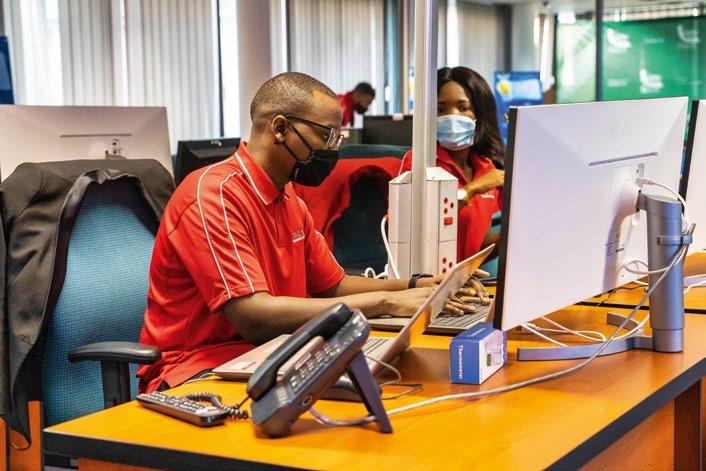
The latest jobs numbers released by Statistics SA show that the official unemployment rate has increased, growing to a record high of 32.6%. Economists had expected the official unemployment rate to rise as a result of new job seekers such as school leavers and graduates entering the labour force. Among the highest unemployment rates were recorded for the youth (those aged between 15 and 24) at 63.3%, and those aged between 25 and 34 at 41.3%.

We believe, however, that there are many untapped opportunities in cybersecurity, given the high demand for these skills and the vacancies that are currently estimated at between 3 and 4 million globally.
Take Note IT runs a Cyber Centre of Excellence that equips young people with these skills and provides them with work opportunities. We are exceptionally passionate about mentoring and creating opportunities for young people in the IT industry. We have championed Take Note IT’s cybersecurity excellence by offering training opportunities to graduates at Take Note IT and its associated companies internationally. This equips them with much-needed work experience, setting them up to be employed in the cybersecurity space.
While we acknowledge the crisis that the pandemic has wrought, we must look for possible green shots that will lead to the recovery of our economy. We at Take Note IT believe that recovery is firmly intertwined with the digital transformation taking place and opportunities it provides. ◆
For further information about our services, visit www.takenoteit.co.za.

Through world-class research and education, the Centre for Renewable and Sustainable Energy Studies is building human capital and promoting innovation
The Centre for Renewable and Sustainable Energy Studies (CRSES) at Stellenbosch University enables a sustainable future for Africa through world-class renewable and sustainable energy research, advisory services, awareness campaigns and training programmes.
Our postgraduate programmes in Renewable and Sustainable Energy studies as well as Smart Grid Technology focus on the training of scientists, planners, economists, project developers and engineers to equip them to work in the fascinating field of renewable and sustainable energy.
Modules from our acclaimed postgraduate degrees are also made available as short courses to the public and private sector. These modules are registered with the Engineering Council of South Africa as short courses that qualify for Continuous Professional Development points. Each of the courses will earn you 4 CPD points.
This course forms the foundation of the various modules in Renewable and Sustainable Energy Studies. It addresses the scientific, engineering and resource aspects of various types of renewable energy systems, and the integration of systems to provide effective and sustainable production and delivery of energy.
Course participants will be exposed to an introductory level of technical insight into the various renewable energy production, storage and transmission systems, and will apply the knowledge in a project-based learning experience.
The course provides an insight into the
supply side of the power system. The focus of the course is on power characteristics of conventional power stations, intermittent renewable power stations and utility-scale energy storage.
Economic dispatch, energy storage scheduling, load-frequency control and inter-area power flow, dynamic system stability and inertia will also be covered.
An overview of applicable network codes and regulations, as well as introduction to power system modelling and simulation software will be discussed.
The course provides an introduction to communications theory followed by an insight into the different communications technologies, both wireless and cable-based, with their application areas and to highlight specific application and requirements for Smart Grid Technology. Basics of information transfer, characteristics, performance, and requirements—as particularly relevant for the Smart Grid— are covered.
The course considers the practical and commercial application of the various technologies for biomass conversion into bioenergy. The production of first- and second-generation biofuels, electricity and heating as the main forms of renewable energy will be covered, with an emphasis on the critical issues of sustainability, energy efficiency and commercial feasibility. The following aspects of bio-energy production are included in the course.
The aim of the course is to provide
attendees with the understanding and tools to design grid-tied (including hybrid configurations with backup power) PV systems within the South African solar resource, technical and legislative contexts. The underlying design criteria is to optimise the energy yield versus lifecycle costs of the PV system within the given resource, technical and legislative constraints i.e. optimising the financial viability of the system.
This module deals with the harvesting of energy from wind. It addresses the availability of the resources, the types of systems and machines, their capabilities and
limitations, the processes of setting up such systems, and their associated costs and environmental impacts.

Ocean and hydro power can make a significant contribution to the generation of renewable electricity. In this introductory course, both ocean and hydro energy associated with the elevation or movement of water is studied, giving students a basic overview of the relevant resources, conversion technologies, project development and implementation, and the associated environmental and economic impacts.
The coursework targets load modelling strategies, short-term load forecasting, demand-side management technologies, measurement, and verification, mini- and microgrids topologies, tariff design and advanced metering infrastructure and data
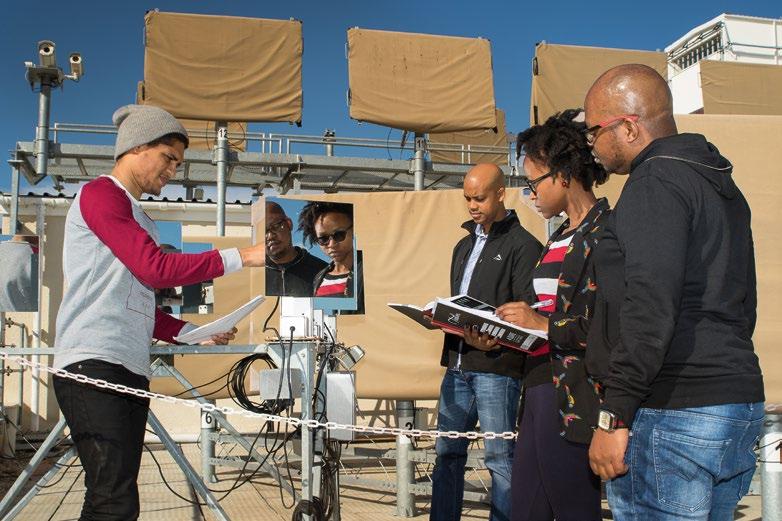
management.
The load modelling component focuses on understanding the concepts involved in deterministic and probabilistic load modelling, and application of these concepts to load forecasting.
The demand-side management component focuses on demand profile and energy management interventions, including maximum demand management, peak clipping, valley filling, load shifting, strategic growth, strategic conservation, and energy-efficient technologies.
The measurement and verification of demand-side management interventions are introduced, including process flow, project planning, baseline modelling, performance evaluation and the reporting protocols that apply. Concepts such as baseline modelling options and methodologies, baseline adjustments, measurement boundaries, energy auditing and uncertainty are addressed in detail.
The tariff design aspects focus on the
theoretical framework for tariff design, particularly with reference to tariff regulations and policies, tariff theory on pricing, and tariff structures and models. Concepts such as smart metering architecture and the use cases for smart metering solutions—including smart billing, smart DSM and smart loss management— are addressed.
The objective is to enable participants to understand the concepts and technologies used for electric energy storage. The course highlights lithium-ion batteries as the dominant technology in new projects and addresses the complex safety, performance and life issues of this technology. The course covers the technical and financial parameters that drive the project designs of gridconnected and off-grid energy storage. Participants become familiar with the major factors that determine energy storage selection and sizing, and receive various case studies to use for benchmarking. The module aims to provide professionals with sufficient understanding to establish the key requirements and financial benefits of energy storage technology and applications in various grid-connected and off-grid systems. ◆
For more information, email crses@sun.ac.za or visit www.crses.sun.ac.za.
Follow us on: twitter.com/crses_us www.linkedin.com/groups/Centre-RenewableSustainable-Energy-Studies-4853266 www.facebook.com/CRSES.Stellenbosch. University
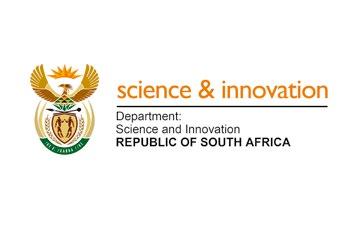

Africa looks likely to continue relying on power from fossil fuels for some time
The narratives of ‘leapfrogging’ to new technologies are pervasive when it comes to development in Africa.
One example is skipping cord phones and landlines to advance directly from limited phone coverage to wide mobile phone usage (bit.ly/3gYgAj8).
Another that is frequently discussed is Africa’s potential for a quick transition to renewable energy. This is important both
from a climate change and an economic development perspective. Providing affordable clean energy is big on the United Nations Sustainable Development Agenda: Goal 7 (bit.ly/3vGoi5c).

Several drivers could prepare the way to Africa’s energy transition. Renewables are becoming increasingly competitive (bit. ly/3xIvLTu), with their costs rapidly declining both globally and in Africa (bit.
ly/3xKq47i). The prices of batteries to balance intermittent supply from renewables are also declining steeply. The average market price of lithium-ion battery packs has fallen to US$137 per kilowatt-hour installed in 2020 (bit.ly/3xFYfgp). This is an 89% decline since 2010.
This downward trend in technology costs is coupled with Africa’s renewable energy abundance. The continent has 40%
of the world’s solar resources (bit. ly/3vuIkQi). And renewables are flexible in scale. For example, solar can power both industrial demand at a gigawatt scale as well as a small mini-grid in a remote village.
But our recently published study (go. nature.com/3eOmXmd) shows that, within this decade, there is currently limited evidence for a quick transition to renewables in Africa. Though the study predicts overall generation to more than double, solar and wind are likely to account for less than 10% of the electricity mix in 2030. According to our estimates, the share of generation based on fossil fuels, especially natural gas, will decline only slightly.
These results were predicted by a machine-learning model we built using a state-of-the-art algorithm for predictive analytics. First, we trained the model to examine drivers behind the successful commissioning of past projects. Then, we applied the model to a pipeline of 2 500
planned power plants across 54 African countries to estimate whether these planned plants would be successfully realised.
Our analysis examined the importance of different project characteristics and country-level development indicators for the successful realisation of power plants. We found that the factors relating to project design are especially pertinent. For instance, smaller project sizes, government or well-designed independent power producer (IPP) ownership structure, and the participation of development finance institutions all have a positive effect on a project.
Technology type also plays an important role. For example, gas and oil power plants have historically had better success chances than most renewable energy projects, with

the exception of more recent solar power plants. Countries’ favourable governance and socio-economic outcomes may also help, but appear to be of relatively lower importance.
Our research highlighted large and critical regional as well as national variations:
First, there were significant geographical disparities in the chances of successful commissioning of planned projects. Some countries and regions are planning generation projects that combine more of the success factors mentioned above than others. We predict 91% of the planned capacity in North Africa will be successfully commissioned. This decreases to 78%, 76% and 71% for southern, West and East Africa, respectively, and drops to only 52% for Central Africa.
Such differences can similarly be strong within a region. For instance, in East Africa, the pipelines in Madagascar and South
Sudan are predicted to have a success chance of below 30%. Ethiopia’s pipeline, on the other hand, which comprises a large share of East Africa’s planned capacity, has a predicted success rate of 85%.
Second, there are spatial differences in the share of non-hydro renewables in the generation mix. For example, while non-hydro renewables are predicted to account for 3% and 6% in all newly added generation in Central and West Africa, respectively, this number increases to 19% and 25% in southern and East Africa.
Third, the predicted pace of the transition to renewables may also vary by country. South Africa is a notable example. Traditionally heavily reliant on fossil fuels, the country is predicted to account for roughly 40% of all new solar generation commissioned on the continent by 2030, aided by its Renewable Energy IPP Procurement Programme (bit.ly/2SppL1F).
The results of our study suggest that as things currently stand, a significant number of African countries may not make a decisive leap to renewables this decade. This implies that countries may lock their economies into a future of relatively carbon-intensive power generation.
Power stations usually operate for decades, locking in capital. This makes the switch from fossil-fuel plants, once built, more challenging and costly than to attract investments into new renewable energy projects.
IF CLEAN ENERGY IS TO POWER AFRICA’S GROWING ENERGY DEMAND, CONSIDERABLY MORE RENEWABLE ENERGY PROJECTS WILL HAVE TO BE PLANNED AND THEIR SUCCESS CHANCES SHOULD BE IMPROVED.
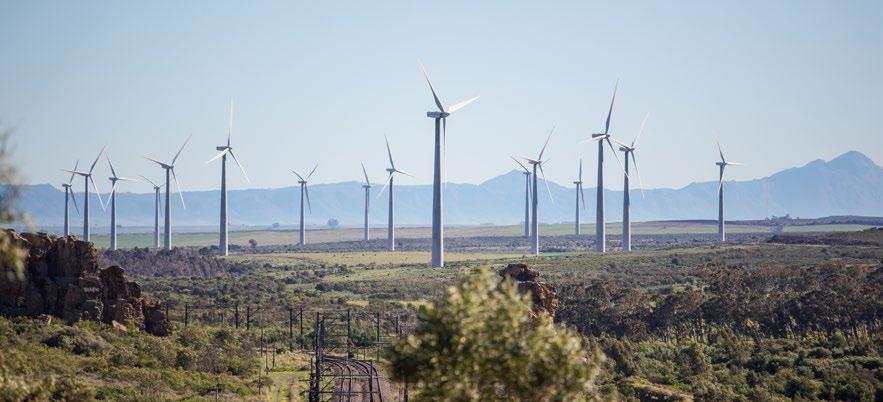

In view of the cost reductions of clean technologies, continued investments in fossil-fuel plants face risks of asset stranding. This is when assets can no longer earn a return, given market and regulatory changes
brought about by the climate change agenda (bit.ly/3gWQMUh).
Therefore, it seems worth closely considering the economic rationale for relying on fossil-fuel-based generation, paying close attention to country-specific endowments and development needs.
If clean energy is to power Africa’s growing energy demand, considerably more renewable energy projects will have to be planned and their success chances should be improved. ◆

Sponsor income-generating work experiences for South African youth—and reap the BBBEE benefits

Agrowing number of multinational mining and resources organisations are creating life-changing work opportunities for South African youth. They are driving social impact and community upliftment, all while bolstering their BBBEE (broadbased black economic empowerment) ratings and Social and Labour Plans (SLPs).
They have joined the more than 1 553 businesses—such as Investec, Toyota, Shoprite, PG Group and South32—that have partnered with the Youth Employment
Service (YES) to co-create a future that works. These powerful partnerships have already created more than 58 500 jobs. Jobs that are creating new taxpayers, new skilled employees and new customers. Jobs that mean a new, more inclusive South Africa.
Through YES, companies sponsor 12-month, income-generating work experiences for South African youth—and reap the BBBEE benefits. They simply
choose a solution that best suits their goals:
• Provide a 12-month work experience within their own company.
• Sponsor the placement of a YES Youth in third-party enterprises or communitybased non-governmental organisations (NGOs), like healthcare workers, teaching assistants, and more.
• Sponsor a YES Youth to grow or support a new enterprise: such as Blossom Care Solutions, a women-led micro franchise that manufactures 100% compostable and affordable menstrual hygiene products.
The Local Economic Development (LED) Plan ensures mining companies contribute to the development of communities where activities take place and where workers are recruited. YES helps with two key aspects of your LED:
By placing youth in these sectors with YES, you:
• increase capacity to locally produce products and services; and
• build infrastructure and services in underserviced communities.
By placing youth in these sectors with YES, you:
• support local business, NGOs and small and medium enterprises (SMEs);
• provide crucial work-readiness and entrepreneurial training through YES digital delivery model; and
• claim up to 50% back on your skills development spend (category F&G).
For the Human Resources Development
Plan, the focus is on developing the skills of both workers and community members. Skills development is not just confined to mining, but extends beyond to include skills in other sectors.
Through the YES IP model, youth from across the country get that first chance at playing an active role in resetting the economy. The IP model offers several benefits:
Companies that are unable to accommodate youth within their own structures can sponsor the placement of YES candidates in third-party organisations, making this a cost-effective option with less admin and more impact.
YES identifies experienced, suitable third-party host organisations from its network of partners that can recruit and provide youth with quality work experiences.
Through YES, 35 IPs have been vetted across various sectors, translating to a wide range of jobs that deliver social impact. These sectors include education, healthcare, SME development, digital, early childhood development, manufacturing, agriculture, conservation and marketing and sales.
YES is a not-for-profit joint initiative between business, government and labour that aims to address the youth unemployment crisis in South Africa. Since being founded 130 weeks ago, YES has worked with more than 1 553 South African companies to create more than 58 500 jobs, with no government funding. This has seen over R3.2 billion being ploughed into communities and the economy through youth wallets. ◆

#SayYES to a future that works. Visit www.yes4youth.co.za for further information.

Kathleen Hlaleleni Dlepu and Daisy Sekao Molefe founded the firm in 1995 and their legacy endures today among our determined and highly skilled team of mostly women lawyers. Under the leadership of directors, Kathleen Dlepu and Solomon Stanley Isaka Boikanyo, who joined the firm as a director in 2014 after Daisy Molefe’s departure to the judiciary, we are a force of excellence, empowerment and progress.
Our vast and growing base of valued clients keeps us committed to a high standard of professional legal services. We rely on years of experience and wellrecognised legal expertise to defend the interests of individuals, private and public companies, government departments and everyone in between. As a client of Molefe Dlepu, you can expect informed, innovative and practical legal advice rooted in ethics and hard-earned skill.
At Molefe Dlepu, we challenge ourselves to redefine the concept of a successful law firm through our devotion to good practice, better people and a stronger society. This starts with raising a generation of brilliant lawyers from previously disadvantaged backgrounds, a majority of whom are women. We also give back to communities through social programmes for the less fortunate and keep a healthy portfolio of pro bono cases. Beneath all our work lies a united belief in access to justice for all.
We want the name Molefe Dlepu to mean merit. We aim to be South Africa’s foremost independent black-owned law firm by establishing ourselves as a reliable source of superior legal services. We nurture a network of relationships with local and international law firms that grow our resources and sharpen our skill set.
Our success and reputation on an international scale is strengthened by our collaboration with diverse talented lawyers that are recognised by associations such as the National Bar Association and the Black Lawyers Association (SA). Our connection to associate firms across the globe lends us the boundless wisdom necessary to handle cases of national and international concern. Molefe Dlepu has the experience, talent and legal arsenal to provide first-rate professional legal services in every case.
As attorneys and litigators, we defend your interests in legal matters ranging from family law to corporate, commercial and financial services. Our team of litigators is trained to be relentless and always wellinformed when defending our clients.
We offer you an ever-expanding catalogue of legal services. Labour law, tender legislation and rules, SABS compliance, regulatory work and policy formulation are all legal spheres that Molefe Dlepu comfortably excels in.
As conveyancers, we handle the full width of property law, including the transfer of property, drafting of leases as well as the registration and cancellation of mortgage bonds – among many other services.
As notaries, we carry out and oversee a range of legal formalities, such as the preparation of contracts, witnessing of signatures and certification of documents. Our highly qualified notaries are a prized resource for consistently legally sound arrangements. We are trusted by the best.



South Africa has its fair share of gas-related incidents reporting fires and explosions costing domestic, commercial and industrial facilities millions of rands. However, these statistics say nothing of numerous other smaller events that occur and go unrecorded, such as boiler fires, process oven failures, piping ruptures, non-conforming installations, and non-suited/non-approved equipment among others. These have been the cause of unpublicised damages and injuries. Unfortunately, action is often only taken on these issues after some large and tragic event occurs.
The Pressure Equipment Regulations (PER) Reg. 17 states: “No person shall…
(a) handle, store or distribute any gas in any manner, which includes the filling of a container, other than in accordance with the relevant health and safety standard incorporated into these Regulations under section 44 of the Act;
(b) install or remove an appliance, pressure equipment or system for gas in any manner other than in accordance with the relevant safety standard incorporated into these Regulations under section 44 of the Act;
(c) install or remove a gas appliance, or a gas system or a gas reticulation system, unless such person is an authorised person.”
Taking the above regulations into consideration, one needs to consider the experience, knowledge, qualification and competency of any person, whether internal or contracted, working in the gas industry
or with gas-related equipment. Unless properly trained and qualified, no personnel or operator should be permitted to attempt repairing/replacing pipes or pressure equipment, tune burners, work on or replace burner management/control systems.
The intent of Reg. 17 is also to ensure all persons working on gas systems are registered and licensed with the registration body, namely the South African Qualification and Certification Committee for Gas (SAQCC Gas).
Combustion equipment safety is critical to the daily operation of all facilities and the safety of every employee, yet awareness on this topic is lacking simply because it is deemed too ‘complicated’. It takes diligence and understanding to protect employees, facilities and industrial organisations from combustion-related incidents involving fuel-fired equipment. Being competent in only a specific field (silo approach) is not enough; persons working on gas systems should have a total understanding of the complete and integrated philosophy and functionality of gas systems (lateral approach).
Once again, understanding the gas system or specifically combustion equipment safety is very critical from a performance and maintenance perspective. An equal degree of emphasis should be placed on the importance of using compliant equipment, which also conforms to the required health and safety standards.
There is typically no screening for how far away from the most recent health and safety
standards the old ‘grandfathered’ technology has become. Passing a statutory inspection sometimes means you could be ‘technically’ in compliance with archaic and antiquated equipment that is 50 or more years old. This could be equipment that requires many manual steps to operate safely and presents serious risk of improper manual startup or shutdown daily. Equipment could be ‘in compliance’ with this kind of inspection, but quite far from the current health and safety standards “level of safety”.
Should grandfather equipment be progressively upgraded in line with newer technologies? Possibly. From a financial perspective, probably ‘no or not now’; from a safety perspective, a definite ‘yes’. The risk assessment of current gas equipment and gas systems needs to be ongoing and analytically direct the way to concrete affirmations of upgrading the site’s equipment. Once an incident occurs, it means years of court cases, job losses and changes, higher insurance rates, and maybe even criminal litigation. It also takes years to overcome the stigma of possible safety credibility to employees, industry and the community at large.
Start with a review of the equipment’s state of protection relative to current health and safety standards: an equipment gap analysis. Prioritise your needs and address them at a comfortable pace. Conduct a human gap
analysis to identify the state of knowledge and skills regarding your operations and maintenance staff. Make training a regular and serious effort.
The bottom line is that by ensuring persons are competent and implementing comprehensive equipment safety programmes, lives can be saved. The right thing to do is to be proactive and at the very least ensure persons working on gas systems are licensed to operate and that manufactured, imported and supplied equipment conforms to the required regulations. Ensure equipment permits are obtained from the required authority, in this case, the Southern African Gas Association (SAGA).
SAGA also verifies Natural and Liquefied Petroleum Gas Industrial Equipment locally manufactured, imported and supplied prior to being placed in the market. This covers all equipment operating above 0.5 GJ/h or 10 kg/h or 140kW in the commercial, industrial and specialised environments. It is being expanded to include natural gas vehicles (NGV), natural gas fuelling stations, compressed natural gas (CNG) and liquefied natural gas (LNG) industrial applications.
The intent is to prevent the import and supply of non-conforming equipment and that all equipment sold or placed in the market meets the Pressure Equipment Regulations.
Using
Never do gas work on piping, appliances or equipment yourself—always use a registered Gas Practitioner. Unregistered gas work is illegal and can be extremely dangerous, resulting in serious injury or even death. Registered Gas Practitioners have the necessary experience, competency, equipment and system knowledge to do the necessary work safely.
Insurance companies may not cover fire
or public liability claims caused by do-it-yourself or non-registered persons, as the gas installations will be deemed illegal.
When using a Gas Practitioner, you need to ensure:
• the person is in possession of a licence issued by the registrar, being SAQCC Gas; and
• the person issues the correct Gas Certificate of Conformity (CoC) to the user on completion of all gas installation work. This applies to all gas work on your property, regardless of whether it is a residential, commercial or industrial property.
A Gas Practitioner is responsible for selective or all the work commencing at the gas meter outlet or reticulation shut-off valve and all the piping, safety and pressure accessories including the appliance/ equipment downstream thereof.
If you notice something potentially dangerous, or any of the following, stop what you are doing and immediately call a registered Gas Practitioner or your gas distributor: Gas appliance/equipment burning incorrectly e.g. yellow or uneven flames, pungent odours, black carbon soot, appliance going out regularly, visible damage to gas pipes.
If you smell gas and you suspect it’s a gas leak, or are unsure, shut off the main valve of the gas system, phone the Gas Practitioner and/or gas distributor of the gas to report the matter.
The main natural gas distributors in South Africa—Sasol (Gauteng, Mpumalanga, KZN), Spring Lights Gas (KZN) and Egoli Gas (Gauteng)—are responsible for work on gas meters and the gas distribution and reticulation system. Virtual piping networks also form part of the distribution system.
You can check if your Gas Practitioner is registered to work in South Africa by searching the register of SAQCC Gas at www.saqccgas.co.za or contact the registrar on +27 (0) 11 285 0038.
• A Gas CoC is an assurance that: the Gas Practitioner is appropriately registered;
• the work completed has been inspected and tested and is proven to be safe;
• the work complies with the requirements of South African legislation such as the Occupational Health and Safety Act, the Pressure Equipment Regulations and respective South African National Standards;
• the Gas Practitioner has officially informed you of the safety procedures as to your gas system; and
• you have met your legal obligation to own a safe gas installation and have a permanent legal record for the job done.
A Gas CoC shall be provided to you after commissioning of the gas system, but no later than 7 days after completion of the following gas work, but not limited to:
• installing new gas pipe work;
• extending or repairing existing gas pipe work;
• installing new appliances/equipment e.g. heaters, hot water units, stove tops, gas trains, burners;
• replacing an appliance/equipment;
• maintenance and/or repair to the pipe work, equipment and pressure accessories; and
• converting a gas system or appliance/ equipment for use on another fuel e.g. from LPG to natural gas or vice versa.
The gas industry is moving away from the hard copy (pre-printed) CoC toward an electronic version that was phased in from 1 March 2021 over a six-month period, whereafter the hard copy will come to an end.
Bringing new technology to the gas industry adds a lot of value especially from a safety and compliance perspective, and ensures ease of doing business straight from a tablet or smartphone.
The CoC needs to be signed by both the Gas Practitioner and the user to be valid.
If you do not receive a Gas CoC, this could jeopardise your insurance if a gas-related incident subsequently causes fire or damage to the property or injury to a person.
If a Gas Practitioner fails to issue the user with a Gas CoC, or refuses to do so, contact the SAGA office. Always remember that Safety Isn’t Negotiable. Ensure the right things are done right the first time.
SAGA ensures all persons working in the methane-based environment are competent to undertake work that complies with the relevant legislation and national health and safety standards in order to provide safe and efficient operations from point of supply to users in the domestic, commercial and industrial markets within southern Africa.
It covers industrial thermoprocessing, CNG, LNG, NGV and biogas by: • providing training to persons working in
the gas industry to become competent gas practitioners;

• developing skills and competencies and ensuring knowledge sharing throughout the industry;
• assisting industry to comply with legislation;

• educating stakeholders in safety and standards;
• advocating the safe and efficient use of gas and pressure equipment; and
• interfacing with government on regulatory issues.
• Establishment of bilateral partnerships;
• Involvement in the Southern African
Development Community Cooperation in Standardisation (SADCSTAN);
• Expansion into NGV and industrial CNG/LNG/biogas environments;
• Collaboration with stakeholders on the adoption and development of Health and Safety Standards;
• Ensuring safety through training and skills upliftment;
• Registration of competent persons to work on gas systems; and
• Practical assessments of competencies and compliance requirements for gas systems: installation, operations, maintenance, commissioning, startup and shutdown activities and much more. ◆
SAGA contact information
Address: 27 Princes Avenue, Windsor West, Randburg, Gauteng, South Africa, 2194 Tel: +27 11 4312016 or +27 11 476 4403 Email: care@sagas.co.za Websites: www.sagas.co.za and www. safegasequipment.co.za
Ensuring all persons working in the methane-based environment are competent to undertake work which complies with the relevant legislation and national health and safety standards in order to provide safe and efficient operations from point of supply to users in the domestic, commercial and industrial markets within Southern Africa. Covers Industrial Thermoprocessing, Compressed Natural Gas (CNG), Liquified Natural Gas (LNG), Biogas, and Natural Gas Vehicles (NGV)....
· Providing training to persons working in the gas industry to become competent gas practitioners · Developing skills, competencies and ensure knowledge sharing throughout industry · Assisting industry to comply with legislation · Educating stakeholders in safety and standards · Advocating the safe and efficient use of gas and pressure equipment


The Petroleum Agency SA represents the government and the people of South Africa in managing a diversified and fully developed upstream oil and gas industry
The Petroleum Agency South Africa (PASA) promotes exploration for onshore and offshore oil and gas resources, and the optimal development thereof on behalf of the South African government. The agency regulates exploration and production activities, and acts as the custodian of the national petroleum exploration and production database.
Dr Phindile Masangane was appointed the new chief executive officer of PASA in May 2020. As arguably one of the best qualified women in the South African energy sector (she holds a PhD in Chemistry, an MBA from Wits Business School and a Bachelor of Science degree), she brings to the position a wealth of knowledge and an array of experiences— including developing, deal-structuring and financing of renewable energy projects. Furthermore, Dr Masangane has participated in national energy policy development including for biofuels, renewables and the gas programme.
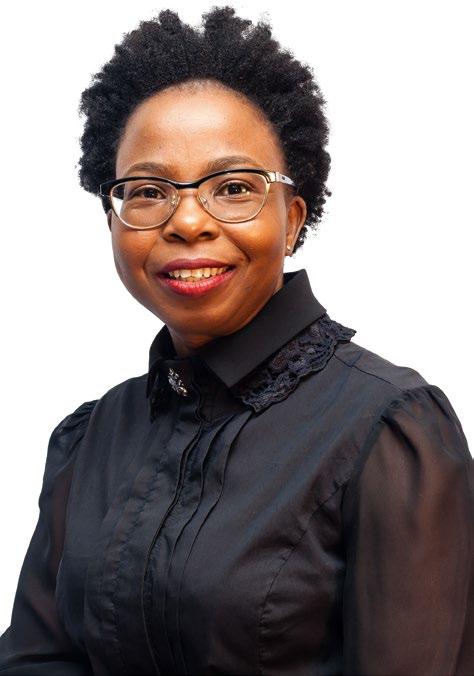
African Business Quarterly spoke with Dr Masangane about, among others, the mandate and work of PASA, as well as its development plans.
PASA promotes exploration for onshore and offshore oil and gas resources and their optimal development on behalf of the government. Please give us some more details about the agency’s mandate. PASA has three main functions, as follows: The first is to attract investment to South Africa’s oil and gas upstream industry; in other words, investment into exploration and production of oil and gas in South Africa. We have a team of geologists and
geophysicists who interpret data gathered through past exploration activity to determine prospectivity, and use this to attract exploration companies to South Africa.
The second function of PASA is to regulate the upstream industry in terms of the Mineral and Petroleum Resources Development Act, its regulations and other applicable legislation. The agency has staff responsible for ensuring legal, technical and environmental compliance as organisations enter into contracts with the state to explore for oil and gas.
The third function is to act as the national archive for all data and information produced during oil and gas exploration and production in South Africa, and to curate and maintain this data for use and distribution.
Other functions include advising the government on any issues pertinent to oil and gas as well as carrying out any special projects as directed by the government.
From the above, it is clear that PASA is the regulator for South Africa’s oil and gas upstream industry. However, the agency by no means sees its role as only reactive. On the contrary, it is one that is proactive—and the agency’s purpose is to facilitate and regulate oil and gas exploration to achieve production of indigenous oil and gas. This will ensure energy security and bolster economic growth, and play a strong role in addressing the eradication of poverty on South Africa.
What is the agency’s focus and development plans for 2021?
South Africa’s upstream oil and gas industry is still in its infancy, despite the country
having excellent petroleum resource prospectivity. In 2021, we want to be focused on supporting our operators to accelerate their exploration activities so that we can have more discoveries.
We will also be supporting Total and its joint venture partners to efficiently move to the next stage of their programme following the discoveries at Brulpadda and Luiperd.
It is of paramount importance to the agency that we move to the next era in terms of upstream oil and gas industry development.
Considering the environment, what issues are considered during exploration processes?
PASA has a role to ensure exploration and production activities are carried out such that the Environmental Right entrenched in the Constitution of the Republic of South Africa is not violated: that is, a right to a clean and healthy environment.
Exploration activities such as seismic surveys and drilling of wells pose various potential impacts on the environment ranging from water contamination, noise and air pollution, to loss of biodiversity. The nature and significance of the potential impacts vary, depending on the exploration method employed. Our experience, based on the environmental impact assessments undertaken at a project level, indicate the majority of the potential environmental impacts range from very low to low significance with mitigation.
Before any right or permit is granted or refused, the applicant is required to apply for and obtain an Environmental Authorisation, which is an instrument used to ensure any potential impacts are identified, their significance assessed, and mitigation measures put in place.
Increases in oil prices can depress the supply of other goods because they increase the costs of producing them. Does this affect the GDP growth rate and economic performance of the oil and gas industry in South Africa?
Oil price increases have significant impacts on the economy’s level of real gross domestic product and economic performance in South Africa. As a net importer of oil, the country is highly vulnerable to oil price increases. Higher oil prices translate into a higher import bill. Imports become more expensive and exports less valuable, and consequently real national income drops. Lower national income reduces demand for both imported and domestic commodities and investment, leading to a drop in GDP.
Different sectors are likely to be impacted differently, depending on their dependence on oil and oil products. In the oil and gas sector, higher oil prices result in reduced aggregate demand for petroleum products. The reduction in aggregate
demand induced by the oil price rise leads to a loss of output and consequently employment in the sector.
At a micro level, this translate into reduced profits and therefore capital returns in the sector that will inevitably result in reduced business confidence and subsequently investment in the industry. These will ultimately reduce the sector’s economic performance and contribution to GDP.
In conclusion, for South Africa the biggest driver of GDP is investment (capital formation), which is dependent on business confidence. Higher oil prices reduce aggregate demand in the economy, drive down business confidence and investment, which ultimately reduces economic performance of all sectors in the economy including the oil and gas sector.
To achieve sustainable and inclusive growth by 2030, South Africa needs to invest in a strong network of economic infrastructure designed to support the country’s medium- and long-term objectives. What is the agency’s targeted development plan toward this goal?
PASA is a regulator and does not undertake any infrastructure developments. Our role is to ensure exploration and production petroleum companies are licensed efficiently to progress their investment projects. The 2030 goal for the country’s energy mix is to have an additional 3 000MW gas-to-power, and our role as the agency is to enable the indigenous production of that gas.
For the future of the oil and gas industry in South Africa, what are the current challenges faced by PASA and what processes are in place to overcome these?

Upstream oil and gas projects are capitalintensive and have long lead times. Our biggest challenge (which is also an opportunity) is to make sure we have regulatory alignment to ensure a sustainable development of oil and gas.
What projects are currently being explored and how will these be escalated during this year?
The agency is concentrating on developing a gas market through the attraction of
qualified and competent companies to explore for gas in South Africa, as well as the monitoring and regulation of their activities. A major area of focus is the increasing inclusion of entities in the upstream industry owned by historically disadvantaged South Africans. The country needs large discoveries of indigenous gas as well as fair access to opportunities and social licence to develop a healthy gas market.

Total and its partners are currently assessing the recent deep-water gas condensate discoveries and the feasibility for development. We are also expecting drilling in the short term in shallow water off the west coast and deep water off the east coast.
How consistent is PASA with the government’s objectives?
Our corporate objectives flow from the medium-term strategic framework objectives of government and the policy positions as well as strategic objectives of the Department of Mineral Resources and Energy, in particular.
In addition to the global economic uncertainty, the African continent is faced with a critical shortage of appropriate infrastructure. What infrastructure and technologies are in place to execute PASA’s mandate?
As a regulator, the agency should have the appropriate technology to efficiently execute its regulatory obligations. We are continuously modernising and improving our technology to be able to operate in the digital environment that the rest of the world is in. ◆

Oil companies are going all-in on petrochemicals—and green chemistry needs help to compete

Global oil consumption declined by roughly 9% in 2020 (bit.ly/3lmKD6i) as the pandemic reduced business and pleasure travel, factory production and transportation of goods. This abrupt drop accelerated an ongoing shift from fossil fuels to renewable energy.
US government forecasts show that oil use for transportation, industry, construction, heating and electricity is declining and will continue to drop in the coming years (www.eia.gov/outlooks/aeo). This trend has enormous implications for the oil industry: As the International Energy Agency observed in 2020, “No oil and gas company will be unaffected by clean energy transitions” (bit.ly/2V7LqgG).
Many of these companies are trying to make up losses by boosting production of petrochemicals derived from oil and natural gas (on.bp.com/3j7MZD8). Today, roughly 80% of every barrel of oil is used to make gasoline, diesel and jet fuel, with the rest going into petrochemical products. As demand for petroleum fuels gradually declines, the quantity of oil used for that ‘other’ share will grow.
This makes sense as a business strategy, but here is the problem: Researchers are working to develop more sustainable replacements for petrochemical products, including bio-based plastics and specialty chemicals. However, petrochemicals can be manufactured at a fraction of the cost. As a biochemist working to develop
environmentally benign versions of valuable chemicals, I am concerned that without adequate support, pioneering green chemistry research (bit.ly/3jhkiUr) will struggle to compete with fossil-based products.

Petrochemicals are used in millions of products—from plastics, detergents, shampoos and make-up to industrial solvents, lubricants, pharmaceuticals, fertiliser and carpeting. Over the next 20 years, oil company BP projects this market will grow by 16% to 20% (on. bp.com/3j7MZD8).
Oil companies are ramping up to increase petrochemical production. In the Saudi Arabian town of Yanbu, for example, two state-owned companies, Saudi Aramco and Sabic (bit.ly/2TNcnW6), are planning a new complex that will produce 9 million metric tonnes of petrochemicals each year—transforming Arabian light crude oil into lubricants, solvents and other products.
These changes are happening across the global industry. Several Chinese companies are constructing factories that will convert about 40% of their oil (bit.ly/3yl51s3) into chemicals such as p-Xylene, a building block for industrial chemicals. Exxon-Mobil began expanding research and development on petrochemicals as far back as 2014 (bit.ly/2Vu91rK).
At the same time, in the US and other industrialised countries, health, environmental and security issues are driving a quest to produce sustainable alternatives for petroleum-based chemicals. Drilling for oil and natural gas, using petrochemicals and burning fossil fuels have widespread environmental (wwf.to/37jeS5u) and human health (bit.ly/3lmR7C8) impacts. High oil consumption also raises national security concerns (bit.ly/3C73lVd).
The US Department of Energy has led basic research on bioproducts through its
TODAY, ROUGHLY 80% OF EVERY BARREL OF OIL IS USED TO MAKE GASOLINE, DIESEL AND JET FUEL, WITH THE REST GOING INTO PETROCHEMICAL PRODUCTS.

national laboratories (www.energy.gov/ national-laboratories) and funding for university BioEnergy Research Centers (bit.ly/3A1kRIQ). These labs are developing plant-based, sustainable domestic biofuels and bioproducts, including petrochemical replacements, through a process called ‘metabolic engineering’.
Researchers like me are using enzymes to transform leafy waste matter (go.nature. com/2VnR8L8) from crops and other sources into sugars that can be consumed by micro-organisms—typically, bacteria and fungi such as yeast. These micro-organisms then transform the sugars into molecules, similar to the way in which yeast converts sugar to ethanol, fermenting it into beer.
In the creation of bioproducts, instead of creating ethanol, the sugar is transformed into other molecules. We can design these metabolic pathways to create solvents (go.nature.com/3fmDcYS); components in widely used polymers like nylon (bit.ly/37bm0Bb); perfumes (bit.ly/2TSeTKS); and many other products.
My laboratory is exploring ways to engineer enzymes—catalysts produced by living cells that cause or speed up biochemical reactions. We want to produce enzymes that can be put into engineered bacteria, in order to make structurally complex natural products.
The overall goal is to put carbon and oxygen together in a predictable fashion, similar to the chemical structures created through petroleum-based chemistry. But the green approach uses natural substances instead of oil or natural gas as building blocks.

This is not a new concept. Enzymes in bacteria are used to make an important antibiotic, erythromycin, which was first discovered in 1952.
All of this takes place in a biorefinery (bit.ly/37eKU2K): a facility that takes natural inputs like algae, crop waste or specially grown energy crops like switchgrass and converts them into commercially valuable substances, as oil refineries do with petroleum. After fermenting sugars with engineered micro-organisms, a biorefinery separates and purifies microbial cells to produce a spectrum of bio-based products (bit.ly/3ymIpHq) including food additives, animal feed, fragrances, chemicals and plastics.
In response to the global plastic pollution crisis (bit.ly/3flJIiw), one research priority is ‘polymer upcycling’ (go.nature. com/3s0eyCB). Using bio-based feedstocks can transform single-use water bottles (bit.ly/3rVrNo0) into materials that are more recyclable than petroleum-based versions because they are easier to heat and remould.
To replace polluting goods and practices, sustainable alternatives have to be costcompetitive. For example, many plastics currently end up in landfills because they are cheaper to manufacture than to recycle (n.pr/3rLrgok).
High costs are also slowing progress toward a bioeconomy. Today research, development and manufacturing are more costly for bioproducts than for established petrochemical versions.
Governments can use laws and regulations to drive change. In 2018, the European Union set an ambitious goal of sourcing 30% of all plastics from renewable sources by 2030 (bit.ly/3C07DOh). In addition to reducing plastic pollution, this step will save energy: Petroleum-based plastics production ranks third in energy consumption worldwide, after energy production and transport.
Promoting bio-based products is compatible with US President Joe Biden’s all-of-government approach to climate change (bit.ly/2V6ecyg). Biomanufacturing investments could also help bring modern manufacturing jobs to rural areas—a goal of Biden’s American Jobs Plan (bit.ly/2VcNiog).
But oil company investments in the design of novel chemicals are growing (bit.ly/3fhUrug), and the chasm between the cost of petroleum-based products and those produced through emerging green technologies continues to widen. More efficient technologies could eventually flood existing petrochemical markets, further driving down the cost of petrochemicals (bit.ly/3jd3deb) and making it even harder to compete.
In my view, the growing climate crisis and increasing plastic pollution make it urgent to wean the global economy from petroleum. I believe that finding replacements for petroleum-based chemicals in many products we use daily can help move the world toward that goal. ◆
Constance B. Bailey Assistant Professor: Chemistry University of Tennessee






The mining sector in Mozambique is realigning with the clean energy transition by harnessing precious minerals required for electric vehicles and lithium-ion batteries

In addition to sizable gas reserves found offshore, Mozambique is home to commercially significant deposits of coal, gold, graphite, ilmenite, iron ore, titanium, copper, tantalum and bauxite, to name a few.
While COVID-19 might have disrupted mining operations in terms of site closures and reduced export earnings, demand for precious minerals and metals has not faced the same fate as oil and gas. In fact, mining commodities have risen in the past year, due to demand for technology products (that rely on copper, nickel, graphite, manganese and lithium) and global green initiatives.
To meet the surge in demand for clean energy technologies, the World Bank posits that mineral production could increase by almost 500% by 2050 and that three billion tonnes of mineral and metals will be required to support wind, solar and geothermal power expansion, along with energy storage.
Mozambique is well-positioned to take advantage of this market boom, with mining operations already expanding across Cabo Delgado, Gaza, Manica, Maputo, Nampula, Niassa, Tete and Zambezia.

In addition to raw mineral extraction, the sector is able to open up opportunities to suppliers across the value chain, in providing mining and refinery equipment, maintenance services, and machinery and automation equipment.
In the production of coal (of which the country holds some of the largest untapped deposits globally), service providers will find
room to grow operations through enhanced provision of coal-mining equipment and railway logistics services. As a result, Mozambique holds extensive opportunities to add in-country value to mining operations—including through the establishment of cement plants, alumina
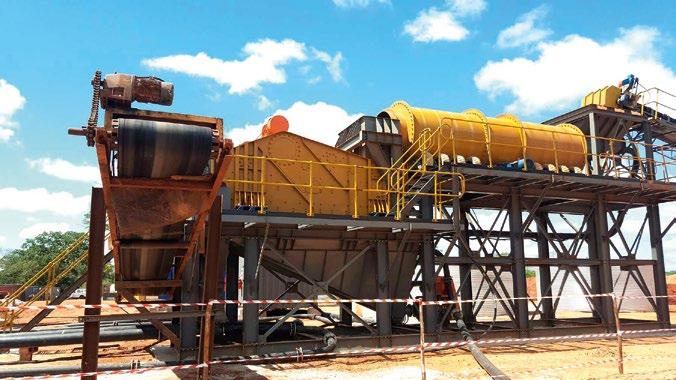
refineries and gas-processing plants—to diversify national economies and give rise to downstream industries.
The mining sector in Mozambique has seen several recent large-scale investments, predominantly from Australian mining firms, that speak to the sizable returns the industry has to offer.
In the mining and processing of heavy
output of 1.2 million tonnes per annum of ilmenite and co-products by the end of 2021. The Moma Mine currently represents the fourth-largest producer of titanium dioxide feedstocks globally. In addition to contributing roughly 5% to domestic exports, the mine employs more than 1 300 Mozambican nationals.
Other large-scale operations include Syrah Resources’ Balama project, which carries a graphite production capacity of 350 000 tonnes per annum and accounts for
A MORE SUSTAINABLE MODEL OF MINING IS EMERGING THROUGH THE EXTRACTION OF ENVIRONMENTALLY FRIENDLY RESOURCESRuby mining at Montepuez Caula Graphite Vanadium Project
40% of the global graphite market, exporting primarily to China and the United States.
Precious minerals remain largely untapped, with gold deposits in the provinces of Niassa, Tete and Manica drawing growing attention from local and foreign investors. London-listed sustainable mining firm Gemfields, for example, invested $130 million into its 75%-owned Montepuez ruby mine, which harnesses ruby deposits in northern Mozambique and produced 1.2 million carats in 2020.
Moreover, the regulatory push from the Mozambican government for artisanal and smallholder miners to legitimise their businesses may unlock further commercialised, large-scale mining activities.
A key determinant of mining opportunities
in Mozambique and across the continent is the global energy transition, which has driven demand for certain minerals needed to fuel electric vehicles and vehicles that rely on hydrogen fuel cells. Mozambique—as well as Tanzania and Madagascar—holds substantial quantities of graphite, which is used in the production of lithium-ion batteries.
While green investors have traditionally excluded mining from their portfolios due to its association with carbon-intensive coal mining, a more sustainable model is emerging through the extraction of environmentally friendly resources. The Caula Vanadium-Graphite Project in northern Mozambique, for example, is being positioned by its developers as a low-cost supplier to the vanadium-flow and lithium battery markets that back electric vehicles and energy storage systems.

On a similar note, an initiative from the World Bank, Climate-Smart Mining, aims to ensure mining is climate-friendly and sustainable for mineral-rich developing countries, and that benefits of extraction are extended beyond just crude revenues. Accordingly, the initiative takes a sustainable resource management approach, focused on utilising renewables to power mining operations (instead of diesel or coal) as well as recycling extracted minerals in a way that yields long-term benefits for local communities.
For rising mining players like Mozambique, the establishment of a circular economy that maximises the full scope of its resources will be integral to building a mining value chain that serves all stakeholders. ◆

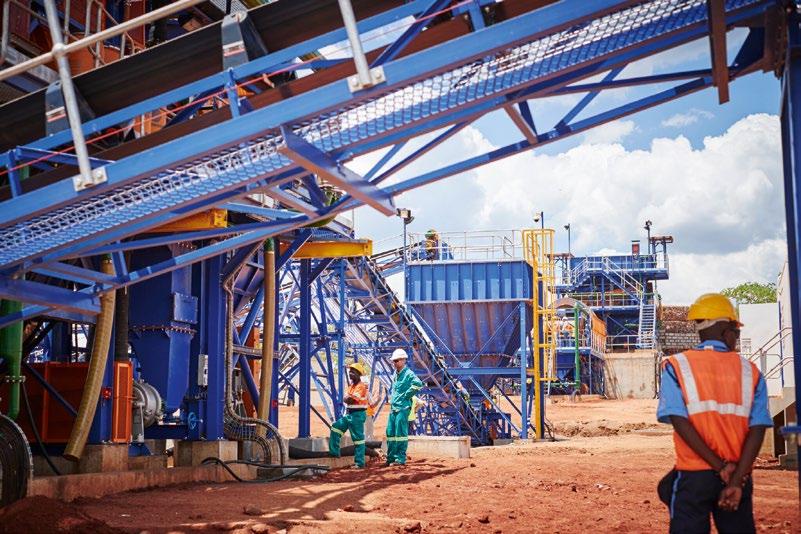

There is growing consensus among both managers (mck.co/3e20fb5) and scholars (bit.ly/32ZWbBO) that corporations need to work with their suppliers to enhance their social and environmental performance. These expectations have increased also because of scandals, such as the 2013 Rana Plaza disaster in Bangladesh in which over 1 100 workers died after a factory collapsed (bit. ly/3nEiZAM). The tragedy highlighted the precarious working and living conditions of garment workers producing clothing for well-known brands like Benetton (bit.ly/335snnf).
Supply chain sustainability efforts are not just there to prevent public relations scandals. They can also have a widespread positive impact, given that many thousands of companies make up the supply chains of corporations (bit.ly/3nxrLQL). Corporate buyers often have significant influence over

suppliers, so they can motivate and enable— or even force—suppliers to improve their performance on human rights and environmental concerns.
But managers of corporate supply chains face difficult questions and differing prescriptions as to how to go about this.
On the one hand, there are recommendations (bit.ly/3vGGPib) that managers should compel suppliers to comply with specified social and environmental standards such as labour conditions or pollution limits. This may be checked through supplier self-assessments, by internal auditors or by third-party auditors. If a supplier fails to comply, they may face penalties—or even lose their contracts. Some argue such coercive systems create the necessary incentives for suppliers to improve their performance on social and environmental issues (bit.ly/3vqYTwq).
On the other hand, managers are advised
Companies should try collaboration—not coercion— when dealing with their suppliers
to adopt a more collaborative approach with suppliers (hbr.org/2020/03/a-more-sustainablesupply-chain). This enables joint learning in the supply chain and more responsiveness to different contexts and circumstances.
Those supporting a more collaborative approach point to evidence (bit.ly/2QxFivX) that coercive systems make suppliers do as little as possible to meet compliance requirements, or even cheat. A coercive approach may foster a ‘checkbox’ mentality and stifle learning and innovation.
In our research published in June 2020 (bit.ly/3vyj8IJ), we looked at these contrasting approaches. We conducted an experiment to compare a ‘coercive’ approach focused on compliance with mandated environmental standards, and an ‘enabling’ approach focused on collaboration.
We found the enabling approach was more likely to create attitudes among suppliers that were conducive to learning. This suggests corporate managers should include an enabling approach in their efforts to increase suppliers’ social and environmental performance.
Our first step was to develop hypotheses about how different approaches may influence supplier engagement on sustainability issues. We built on influential prior work on two kinds of administrative systems (bit.ly/3gOymVY). Coercive systems focus on compliance with specified requirements; enabling systems emphasise learning, flexibility and collaboration.
Our hypotheses focused on how these systems influenced supplier managers’ attitudes to the administrative system, to sustainability goals, and to their relationship with the corporation. We focused on attitudes because they tend to shape engaged behaviour in organisations (bit.ly/3gOUajV).
We tested these hypotheses in a large South African insurance company. An experimental research design (bit.ly/3vu3rSE) can help address some of the methodological constraints of cross-sectional studies comparing different companies and contexts.
The corporation we chose was making a new effort to improve sustainability performance among its suppliers. The focus was on its over 1 000 motor body repair service providers. These suppliers had
important sustainability challenges related to, for example, air and water pollution resulting from paint spraying, or the disposal or recycling of old car parts such as bumpers.
We invited 900 suppliers to participate in the experiment and eventually had a sample of 113 go through the whole process. We divided suppliers into three groups, including a control group. All suppliers were asked to complete a baseline survey to measure their attitudes.
One group was asked to respond to an additional set of open-ended questions that represented an enabling approach. These questions explored how the suppliers planned to address sustainability issues, and how they may be supported in that process.
For example, one of the questions was: “Are there ways in which your company could dispose of solid and liquid waste in a more environmentally sustainable way?”
The questions were meant to communicate the corporation’s interest in collaborating with suppliers toward shared environmental objectives.
approach fostered positive attitudes among suppliers about corporate efforts to enhance the supply chain’s sustainability performance. Suppliers who received the enabling treatment felt the administrative system in the supply chain supported learning. The treatment also strengthened their views that sustainability goals were important for the corporation.
In contrast, the coercive approach did not produce such positive attitudes. Instead, it eroded some suppliers’ belief that they could raise and discuss issues with the corporation.
The implication for managers is that they should be careful about adopting too coercive an approach. This can harden attitudes and diminish the willingness and ability of suppliers to learn and share information with their partners.
This does not mean performance standards and monitoring should be left out of supply chain strategies. But these kinds of compliance-oriented elements should be combined with efforts that signal a
Another group received a more focused and restrictive set of questions, including requests for specific quantitative data. This represented the coercive approach. For example, one of the questions was: “What environmental safeguard has your company implemented for its spray booths?”
Respondents had to choose from three response options.
Three months later, all respondents were asked to complete a follow-up survey to assess how their attitudes had changed during the process.
willingness to collaborate with suppliers on finding sustainable solutions. ◆
Ralph Hamann
Professor: Organisations and Sustainability, University of Cape Town
Frank Brueck Stellenbosch University Business School
Franz Wohlgezogen
Senior Lecturer: Management and Leadership, University of Melbourne
AN ENABLING APPROACH
Our findings confirmed an enabling
Joerg S. Hofstetter
Associate Professor: Supply Chain Management, Kedge Business School
COMPLIANCE-ORIENTED ELEMENTS SHOULD BE COMBINED WITH EFFORTS THAT SIGNAL A WILLINGNESS TO COLLABORATE WITH SUPPLIERS ON FINDING SUSTAINABLE SOLUTIONS.





































































Nigeria isn’t big on 3D printing—teaching students how to use it could change this situation


The technology of 3D printing is forecast to change the world (bit. ly/3t9gnMs). Already several Fortune 500 companies—such as Siemens, General Electric and Boeing— have invested in it (bloom.bg/3vqAzL6).
3D printing mimics regular paper printing, where a computer-aided designed part is sent to a printer for direct manufacture. Technically, this involves the digital data of a computer-aided 3D model design being sent to the printer, which then produces the object layer by layer. The process enables the conversion of almost any virtual object into real parts.
In more developed countries, 3D printing is already being introduced into design workflows by several manufacturing giants. However, in less developed countries like Nigeria, little is known about vast aspects of the technology—even in academic institutions.
In our study (bit.ly/3dYC7WS), we set out to investigate how well-versed people in Nigeria’s industrial and educational sectors were about the technology. We also wanted to assess whether it should be introduced to science and engineering education in the country. We took this approach because the
growth of 3D printing in Nigeria is expected to affect manufacturing as well as the education sector.
We concluded from our research that the technology is lacking in the Nigerian industrial setting. We also found it offers the opportunity for new teaching practices in science and engineering programmes because it has the rare advantage of applying to anyone with a basic understanding of computer-aided design. This can range from senior secondary school students to university students and professionals.
the technology and its capabilities.
We found that over 90% of the participants had heard of 3D printing, but only 38% had a basic understanding of the technology. And only 12% indicated their ability to use fused deposition modelling, arguably the most popular 3D printing polymer technology.
The fact that so few people know how to use the technology is not surprising.
Engagement with 3D printing in Nigeria’s manufacturing sector is low.
In 2017, Nigerian Foundries Limited,
We surveyed more than 60 participants from various universities and industries in Nigeria. We tested respondents on their awareness of
one of the leading ferrous foundries in Africa, bought the largest 3D printer in West Africa from Titan Robotics (3dprint. com/187035/titan-robotics-west-africa). This

3D PRINTING MAY CONTINUE TO BE SIDELINED IN THE INDUSTRY UNTIL DELIBERATE ATTEMPTS ARE MADE TO SUPPORT LOCAL MANUFACTURE AND LIMIT IMPORTATION.3D printing at Nigerian Foundries Limited
printer, the Atlas, is used to speed up the creation of a range of patterns needed for moulding and casting clients’ products. But this is a rare example in the country.
Aside from awareness and a deficit in skills, adopting 3D printing has faced another major hurdle in Nigeria: the reliance on imports. Nigeria’s growing reliance on imported goods has hindered local content development and in turn hindered localised manufacturing. Only a few well-established manufacturing companies are able to compete with importers.
3D printing offers itself as a convenient method of local manufacturing because it can be customised and has relatively low production outputs.
In the educational sector, we found that 3D printing efforts were less than average. A few universities boast of owning 3D printers. But these were often left idle in research centres, and out of the reach of students who will benefit from using them.
Some outliers, like the University of Lagos, said they had received donations of 3D-printing equipment ( And they have gone ahead to set up


hackathons for students.
These efforts are notable. But more is necessary to ensure students are adept with the technology. This will foster more robust research and general knowledge of 3D-printing technologies within academic institutions and industries likewise.
There are several consequences of low 3D printing adoption in Nigeria. One is the skills gap between industry and university students. This gap progressively widens as technological advancements speed up. It makes it difficult for employers, ready to research and implement these emerging technologies, to find skilled and knowledgeable recruits.
On the flip side, students skilled in 3D printing also face a lack of gainful employment because of the technology’s low-level adoption among manufacturing companies.
in the industry until deliberate attempts are made to support local manufacture and limit importation.
Other great options the government should explore include loans to digital manufacturers, and awareness campaigns.
But possibly the biggest boost could come from introducing 3D printing in the educational sector and curriculum. This would afford high school and university students the opportunity to engage with the technology, improving their knowledge and cognitive skills.
Students in an academic setting could be given opportunities to perform projects and solve problems based on practical scenarios. Project-driven teams could be set up for research or student competition purposes. 3D printing could also be introduced in form of practical courses in a laboratory.
The government should also consider providing schools with facilities that encourage the adoption of 3D printing adoption. Examples include open-access laboratories equipped with 3D printers, and funding countrywide competitions that encourage manufacturing ideas. These kinds of competition models have been successfully implemented in the US.
3D printing in industry is virtually absent from Nigeria’s industrial sector. It is also virtually absent as a subject in the education sector. One way to unleash its potential in the manufacturing sector would be to educate students. This can help students improve skills and knowledge in advanced manufacturing, thus making them more competitive in the industry.
It could also be a backbone for local manufacturing, encouraging individuals to develop startups with ‘homegrown’ solutions. ◆
Ibhadode Research Assistant, University of Waterloo Akii Ibhadode Professor: Manufacturing Federal University of Petroleum Resources
Insights from the effect of a bridge across the Zambezi on maize prices

Investments in infrastructure, such as roads, typically aim to reduce transport costs, stimulate trade and make new production activities viable. Across sub-Saharan Africa, the need for such investments is widely acknowledged (brook. gs/3e7lLLL).
The argument for more and better infrastructure seems fairly compelling. But little rigorous evidence has been collected about the magnitude of the economic impacts from such new investments. In part, this is because new investments often respond to new activities, such as growing cities, and are not necessarily independent causes of that growth.
To get around this, researchers typically focus on so-called ‘exogenous shocks’, where neither the location nor timing of changes to infrastructure can be explained by existing economic factors. In Mozambique, one such positive shock occurred in 2009 with the completion of a major bridge over the Zambezi River, financed primarily by external development partners (bit.ly/3u6WYNn).


The Armando Emilio Guebuza Bridge was important for two reasons. First, before it was constructed, the river formed a natural barrier to direct north–south trade along the main highway. Historically, there was a ferry service. But it was extremely inefficient. The journey lasted less than 30 minutes, yet the ferry only ran from 7 a.m. to 5 p.m., was notorious for breaking down, and was frequently suspended during the
hours and even days were common. Also, alternative options were limited, necessitating extremely lengthy detours.
difference in maize prices between market pairs that did, and did not, use the bridge to trade (bit.ly/3e34Zx1).
Second, the new bridge was constructed at the same point as the old ferry. So, rather than creating new driving routes, the bridge simply made crossing the river more efficient and reliable, reducing the overall journey time. And the toll for crossing the bridge was
According to the ‘law of one price’ expounded by economists (bit.ly/331ZVmq), opportunities for arbitrage will tend to ensure the difference in prices between goods produced in place A and sold at place B only reflect transport costs: in other words, competition between traders should drive any opportunities for additional profit down to zero. So, because market pairs that did use the bridge to trade experienced a positive shock to the quality of their transport infrastructure, we would expect their transport costs to fall—and this should be reflected in smaller price differences.
Comparing the groups of market pairs that did and did not use the bridge to trade, we found that differences in maize prices did become smaller for the first group. In other words (consistent with the law of one price), their maize markets did become more closely integrated. Even so, we found this was only the case for relatively close market pairs. For others, driving distances remained so large that the gain from the bridge was negligible.
THE CONSTRUCTION OF THE BRIDGE DID SIGNIFICANTLY IMPROVE THE INTEGRATION OF MAIZE MARKETS IN MOZAMBIQUE
Figure 2: Change in absolute relative maize prices (y-axis) vs relative difference in journey times associated with the new bridge, treated market pairs only

Maize is the staple food in Mozambique, consumed predominantly by the poorest households. While it is also produced by small farmers, there are large distances between the most productive areas in the centre and the north, and the main urban centres of demand in the south.
Historically, poor transport infrastructure—including just one north–south road, no integrated national rail network and no coastal shipping services— has meant differences in prices for maize can be very large over the country. As we plot in into Figure 1, for agricultural markets located more than 250 kilometres apart, on average maize prices are at least 25% more expensive in destination versus origin locations. And, at times, this average difference has reached over 40%, such as during the food price crisis of 2007/08. Using data from Mozambique’s agricultural market data system and applying a variety of econometric techniques, we found the bridge did indeed have an effect on maize price differences. We found a positive relationship between changes in the journey time associated with the opening of the bridge and changes in absolute price differences. For the closest market pair using the bridge to trade, located just under five hours apart, we estimate the opening led to an approximate 7% reduction in maize price differences. Given the long journey times between many markets in Mozambique, most market pairs that use the bridge to trade experienced only small relative changes in journey times due
to the opening of the bridge. As summarised in Figure 2, which plots the change in absolute relative maize prices against the relative difference in journey times
important expenditures. As we saw during the prelude to the global financial crisis of 2007/08, rising food prices often spilled over into political unrest (bit.ly/3nByE3v).
But stabilising prices is fraught with difficultly. On the one hand, we see the construction of the bridge did significantly improve the integration of maize markets in Mozambique. Other agricultural commodity markets, especially for products that can be easily stored and transported in bulk, benefited from the bridge.
On the other hand, the benefits appear to be fairly narrow. A comparatively small number of market pairs substantially benefited from the new investment. For others, the improvement in journey times was not sufficient to seriously reduce trading frictions between the capital city and areas of surplus maize production.
Overall, very careful cost-benefit analysis must be undertaken when embarking on
Figure 1: Average absolute relative difference in maize prices between markets more than 250km apart.
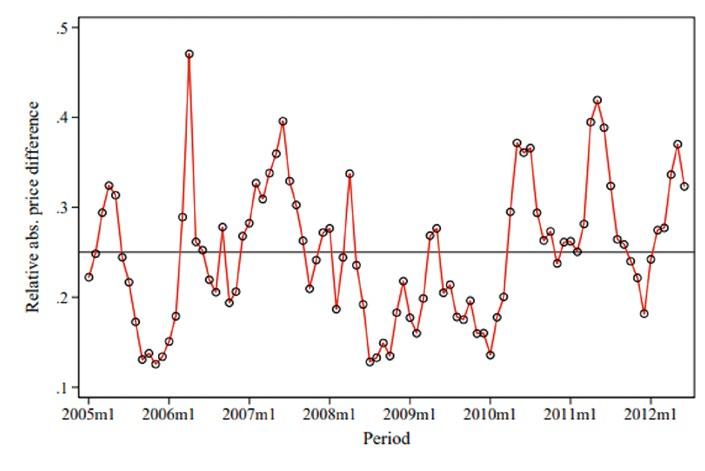
associated with the bridge, only market pairs that experienced a more than 20% fall in journey time saw a significant reduction in maize price differences.
Understanding what drives food prices is important because these prices are critical to the well-being of the poor. Sudden price increases can drive many consumers into poverty, with knock-on consequences for other
major infrastructure investments. In themselves, they are rarely a panacea for the difficult trading conditions facing many rural producers, and provide no guarantee of price stability. ◆
Sam Jones Research FellowWorld Institute for Development Economics Research
United Nations University

How chemical recycling technology could help fix the problem of plastic pollution

It is impossible to imagine everyday life without plastics. Lightweight, durable and cheap, these materials outperform many others in a diverse range of applications (bit.ly/33jKm9D).
Plastics have brought about positive change in ways we often overlook. For example, the development of plastic components in electronic devices—such as the one you are using to read this article— means we have never been more connected to the world around us.
But our love of plastics has come at an environmental cost. It has been estimated that of the 8.3 billion tonnes of plastic made between 1950 to 2015 (bit.ly/3eTf8vw), over 75% is now waste, with 79% accumulating in either landfill or the natural environment. For scale, that is more than all living things on Earth (go.nature.com/3nKnlpS), and our oceans are drowning in plastic (bit.ly/2Spf6Ed).

Because of this, recent research efforts have focused on addressing these mounting environmental concerns. One of these is chemical recycling.
To overcome the huge environmental concerns created by plastic, we need to start valuing plastic waste as a resource. After all, plastic waste contains value in the form of stable chemical bonds, so at the very least
we should try to recover that energy. In fact, the stability of these bonds is why plastics linger for so long in the environment.
Beyond burning plastic to recover this energy, we can also recycle plastic. The world currently relies on mechanical recycling, where plastics are sorted, melted and remoulded to create mainly lower grade plastic products (bit.ly/3ui5UQ5). But this process is limited. The harsh conditions involved mean each time a piece of plastic is recycled, its performance properties are
way at scale. Traditional methods are usually costly and energy- or resource-intensive, which has limited their widespread use.
Plastics are made up of long-chain molecules known as polymers, which consist of smaller repeating building blocks called monomers. These monomers come in different shapes and sizes, and the bonding between them determines the plastic’s material properties— such as melting temperature and toughness—
negatively affected. This limits the number of times a piece of plastic can be recycled.
To make sure plastic keeps its value in the long term, we need alternative recycling strategies. Chemical recycling provides the potential for infinite recyclability (bit. ly/3vDNFVt). But the challenge lies in achieving it in a sustainable and economic
which affects the way it is used.
While mechanical recycling involves melting, chemical recycling relies on a chemical transformation and thus breaking the links between monomers. Chemical recycling breaks down the plastic at a molecular level (go.nature.com/2PLwbXU). This means the monomer can be recovered
TO OVERCOME THE HUGE ENVIRONMENTAL CONCERNS CREATED BY PLASTIC, WE NEED TO START VALUING PLASTIC WASTE AS A RESOURCE.
in what is called closed-loop recycling (go. nature.com/3xFHQZD), or the plastic waste can be transformed into other higher value chemicals in open-loop recycling (bit. ly/33e61QE). For many types of plastic, it is possible to recover monomers or other useful materials.
Some plastics, such as polyolefins (the material in a polyethylene plastic bag), do not have weak monomer links, making it harder to chemically recycle them. In such cases, a process called pyrolysis is used: a different process to burning, which relies on high-reaction temperatures to typically produce fuels and waxes (bit.ly/2PLwu50).
Catalysts are used in around 90% of industrial chemical processes (bit. ly/3ulqf71). They make the process more efficient by providing the reaction with an alternative route, much like the way Google Maps optimises your journey. They can also allow us to be selective about what product is created and reduce waste. Such benefits
are central to ensuring chemical recycling can be performed both sustainably and economically at an industrial scale.
The enzymes that were working tirelessly during your last meal are naturally occurring catalysts that play an important role in digestion (bit.ly/3nJwkYm). Enzymes that can even break down plastics have been reported (bit.ly/33dDACE).
However, these processes are limited by their productivity (go.nature.com/3ehplDa) and require specific process conditions such as the right temperature and pH (bit. ly/3h1w45M) to keep the enzyme active. But given how rapidly the field is advancing, using naturally occurring catalysts may be commercially viable in the future.
We have developed highly efficient metal-based catalysts (bit.ly/3eUkUgj) for the chemical recycling of polylactic acid (PLA), a plastic made from plant starch. This work used cheap and abundant metals such as zinc or magnesium, targeting chemicals called lactate esters that are a potential green alternative to petroleum-based solvents
(rsc.li/3uidI4k).
This area remains in its infancy, but we expect significant developments— particularly in process optimisation—to be made as the field gathers momentum. This is, in fact, a general endeavour of the field because traditional methods typically use harsh chemicals, and can be resource- and energy-intensive.
Beyond PLA, there is the potential to ‘upcycle’ other plastics, such as polyethylene terephthalate (PET), which is used for plastic bottles (rsc.li/3eVbRf8). Recent examples include building blocks for high-performance materials (rsc.li/3ujFFZk) and antibiotics and corrosion inhibitors from PET waste (bit.ly/3xI8zod).
Our recent work (rsc.li/3tk9B6m) has also investigated the chemical recycling of PET, which is used far more extensively. PET is used more widely in plastic bottles and food containers, while PLA takes up a much smaller share of the market, used mostly for 3D printing, biomedical devices and certain packaging applications.
Given society’s diverse plastic use, a one-solution-fits-all approach is not feasible. Diverse and tailored recycling strategies are needed for both existing and new emerging plastics. However, commercial-scale chemical recycling operations are underway (on.bp.com/3ePJ8Zb).
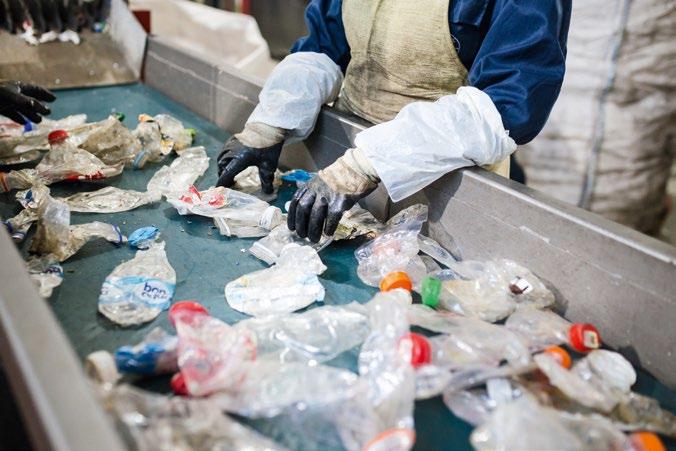
In the future, we expect chemical recycling to complement its mechanical counterpart, especially for difficult-torecycle materials such as thin-films (bit.ly/3tlM5pv).
One thing is for certain: plastics are here to stay. With production expected to exceed one billion tonnes by 2050 (rsc.li/339zoDQ), chemical recycling promises to be an exciting space to watch. ◆
 Matthew Jones Professor: Chemistry University of Bath
Jack Payne PhD Candidate Centre for Sustainable and Circular Technologies
University of Bath
Matthew Jones Professor: Chemistry University of Bath
Jack Payne PhD Candidate Centre for Sustainable and Circular Technologies
University of Bath
Customer loyalty and satisfaction stakes have hit a high in the digital COVID economy

When South Africa entered into a hard and extended national lockdown on 27 March 2020, banks responded rapidly and empathetically to their account holders’ financial crisis. They earned a significant amount of goodwill and loyalty with their rapid and wide-scale debt-relief responses at the time. However, they will need to work hard to leverage this position as a protracted pandemic tests every facet of customer resilience and loyalty in a tough and uncertain economy.
Even prior to COVID-19, the technology and innovation drive of banks
had already served to increase customer expectations of online capability combined with more personalised offerings and services. The arrival of the pandemic and hard lockdown redirected banks and their customers to an increased reliance on digital tools, processes and self-service channels as a replacement for in-branch and call centre interactions.
The digital acceleration brought about by the adaptation to a new multi-channel, connected normal—combined with consumer financial distress—have further increased customer expectations off an already high base, while reducing their
tolerance for a bad customer experience.

These are just some of the findings of the 2020 South African Customer Satisfaction Index (SA-csi) for Banking conducted by Consulta, providing highly scientific insights into the overall level of satisfaction of customers of South Africa’s top retail banks.
Consulta polled almost 12 500 customers from the lower, middle and upper retail banking segments on their overall satisfaction with South Africa’s big six retail banks during 2020: Absa, African Bank, Capitec, FNB, Nedbank and Standard Bank.
“It has been a tumultuous year in terms
of customer satisfaction and loyalty,” says Ineke Prinsloo, head of Customer Insights at Consulta. “Every aspect of customer service and engagement has been radically changed by technology, digitisation and remote working models. Banks and their customers adapted to new technology platforms and unprecedented circumstances.
“On one side, banks were heavily challenged in ensuring their commercial interests, business operations and customer service channels continued unencumbered, despite not having made budget provisions for the massive increased costs of doing business in a black swan pandemic environment. On the other side, consumers faced devastating challenges that regressed consumers right back to simply trying to secure their most basic physiological and safety needs under significant financial and emotional duress.
“Every aspect of the customer journey has been fundamentally upended, with many self-service channels from artificial intelligence, chatbots, apps and contact centres opening up between banks and their customers. While these were necessary measures to deal with unprecedented times and high levels of service enquiries at the time, they also have significant consequences for customer experience, expectations and
satisfaction—now and into the future,” she explains.
“Getting every aspect of the customer experience right, no matter which service platform is used, is a perpetual task of refinement to deliver consistency in a world
for every customer enquiry.”
The pandemic experience also proves that digital and online banking channels are no longer the key differentiators they were a few years ago, but are expected as standard by customers, with banks rapidly reaching a

where customers no longer differentiate between their online and offline experiences. Customer satisfaction and experience in the banking sector are now decentralised and shaped across a wide and complex array of online and offline service platforms: from contact centres, to banking apps, to webchats, to in-branch visits right through to rewards programmes. Banks are under pressure to ensure every banking functionality is value-adding, seamless, simple and provides the first-time resolution
point of technological parity, more so as a result of the pandemic experience. In a tough economic environment where household income and expenses are under enormous pressure, customers place far more emphasis on perceived value for money, quality of service received, and emotional brand connections, and whether these correlate with each other.
Prinsloo explains, “Beyond the transactional aspects of banking, this also has implications for rewards programmes.
“ EVERY ASPECT OF CUSTOMER SERVICE AND ENGAGEMENT HAS BEEN RADICALLY CHANGED BY TECHNOLOGY, DIGITISATION AND REMOTE WORKING MODELS.”
It will be essential for banks to show the real financial benefit of their programmes in hard, cash value and simple terms. More than ever, consumers are now seeking out monetised value, and they don’t want to jump through hoops to get it. Standard Bank and Nedbank both enjoyed positive mention in the latest SA-csi for Banking of their rewards programmes based on their simplicity and cash value. It is clear that overly complex programmes that require more effort from consumers to ‘earn’ rewards will kill any intended value.
“Banks also need to guard against diversifying too far from the core services of a transactional bank in their reward offerings, either with overly complex, bells and whistles measures to earn points, or in the offers provided which have a tenuous link to banking, or by penalising and thus disincentivising consumers who don’t abide by certain behavioural expectations of
such programmes. These will quickly be dumped by consumers who have less patience than ever before and are not prepared to pay the time and effort premium for a questionable reward value at the end of the day,” she adds.
Managing every experience touchpoint across such a diverse customer journey must be the absolute focus for banks as they seek to consolidate their positions by reconnecting with their customers across multiple service platforms. This is all happening against a backdrop where banking brands are, in fact, becoming increasingly invisible and digitisation decentralises customer experience.
“In two of the studies conducted last year—the SA-csi for Banking and a proprietary Consulta Market Share study launched after the collapse of the AMPS study a few years ago—Nedbank had the most notable improvements, namely the

Capitec (84.7) is once again the leader, followed by African Bank (83.4), Nedbank (81.1) and FNB (80.2).

Customer Expectations within the banking industry continue to rise to new highs of 83.1 (compared with 82.4 in 2019). In terms of Perceived Quality, Capitec, FNB, Nedbank and African Bank lead the sector.
Capitec (87.7), African Bank (84,2) and Nedbank (78.1) are in leader positions. FNB (76.0) is on par, and Absa (73.6) and Standard Bank (74.5) are below par.
• Capitec has the lowest Complaint Incidence (11.9%) and a high
Complaint Resolution rate of 55.4%, in line with global benchmarks.
• African Bank has the second-lowest Complaint Incidence rate (14%) and the highest Complaint Resolution date of 59.7.

• FNB has the highest complaint incidence (23.0%) and the lowest complaint resolution rate (49.8), followed by Standard Bank, with complaint incidence at 22.5% and a resolution rate of 51.9.

• Capitec (76.7%), African Bank (76.2%), Nedbank (73.5%) and FNB (72.8%) have the most loyal customers.
• FNB has shown a five-year decline in customer loyalty scores from a high of 75.3% in 2016 to 72.8% in 2020.

• Absa (70.4%) and Standard Bank (69.3%) have the least loyal customers and are below par.

most consistent improvement in the SA-csi over the last five years, as well as the maintenance of its market share in one of the toughest economic environments in our history. Alongside Capitec’s consistent performance in the customer satisfaction stakes (and also the only bank to grow its market share in the last year), these are proving to be the banks to watch as the sector gears up for a massive fight for the consumer’s share of mind and wallet,” says Prinsloo.
It is pertinent to point out that while South Africa’s banking sector is world-class in customer satisfaction, expectations remain incredibly high. It is evident that some banks have been leaps ahead of their peers in managing the customer journey’s rapid transformation in a pandemic environment, with many of these trends and customer behaviour now more entrenched than ever before. ◆
• This measures the likelihood of a person to recommend a brand to friends, family or colleagues. Capitec (56.6%) and African Bank (50.8%) have the highest NPS.
• FNB has shown a five-year decline in customer loyalty from a high of 47% in 2016 to 39.8% in 2020.
• Absa (26.9%) and Standard Bank (24.41%) remain far behind and well under par. Both banks have the lowest number of promoters at 50% and 49%, respectively, and the highest number of detractors at 23% and 24%, respectively.
The degree to which customers feel they are being treated fairly by their banks is highest with African Bank (86.3), Capitec (86.3) and Nedbank (82.9).

Bill Gates was 21 when he and Paul Allen registered Microsoft. Steve Jobs was 22 when he and Steve Wozniak launched Apple. Mark Zuckerberg started Facebook in his Harvard dormitory.
The biographies of these tech billionaires who achieved great success in their 20s has helped cement the perception that entrepreneurship is a young person’s game. Not true. Such stories are the exception rather than the norm.
Starting young can have some clear advantages. For one thing, it gives you much more time to fail the several times most entrepreneurs do before they put it all together and succeed.
But overall, the research suggests, older age is associated with higher levels of entrepreneurial success.
That is an important policy point for governments that want people to keep working (and paying taxes) longer, even though employment prospects for job

seekers decline significantly from about the age of 45 (bit.ly/2RoExVG).
Rather than just putting money into ‘job ready’ programmes or subsidies for employers to hire older workers, more should be invested into programmes to support the demographic with the best chance of successfully starting new businesses.

My research (bit.ly/3thyqQm) with Bronwyn Eager (University of Tasmania) and Saskia De Klerk (University of Sunshine Coast) suggests mature-aged entrepreneurship— after the age of 50—is growing faster than among any other age group in Australia. Mature-aged entrepreneurs run about a third of all businesses that are less than three years old.
Younger entrepreneurs do have some advantages. As a group, they are healthier and tend to have fewer family obligations. They may be less risk-averse, often because they have less to lose. The may also benefit from others’ positive perceptions of them as ‘youthful’.
But mature-aged entrepreneurs have three key advantages: human capital, social capital and financial capital.
Our research involved surveying more
than 1 000 mature entrepreneurs and correlating the results to other studies on entrepreneurs. Our findings indicate older entrepreneurs have accumulated business and life experience, knowledge and skills, social networks and resources that better equip them for success. They tend to have better social skills, and are better able to regulate their emotions, than those younger.
They do have a lower risk tolerance than younger entrepreneurs, but that is offset by other factors such as confidence in their abilities and experience. Their fear of failure is thus less than their younger counterparts.
Our research supports previous studies finding no evidence to suggest younger entrepreneurs are more likely to succeed than those in middle age.
MIT Sloan School of Management professor Pierre Azoulay and colleagues, for example, analysed the data (bit.ly/3nHlORv) on 2.7 million founders of US companies between 2007 and 2014 that went on to employ at least one person. The average age at founding was 41. For the ‘1 in 1 000’ highest-growth ventures, the average age was 45.
The authors conclude that “all evidence points to founders being especially
successful when starting businesses in middle age or beyond, while young founders appear disadvantaged”.
Indeed, they found the “batting average” for creating successful firms rose dramatically with age. A 50-year-old founder was 1.8 times more likely to achieve “upper-tail growth” than a 30-year-old founder. Those in their early 20s had the lowest likelihood of success.
Entrepreneurship may therefore be a viable alternative to mature-aged unemployment. There is, however, compelling evidence that aspiring mature-aged entrepreneurs require specialised government support and incentives, both to start their businesses and grow their businesses.
Government initiatives could be better designed to account for the specific needs of mature-aged entrepreneurs.
Such support will both enhance the success of these businesses—and employment prospects for young and old. ◆
Alex Maritz Professor: Entrepreneurship La Trobe Business School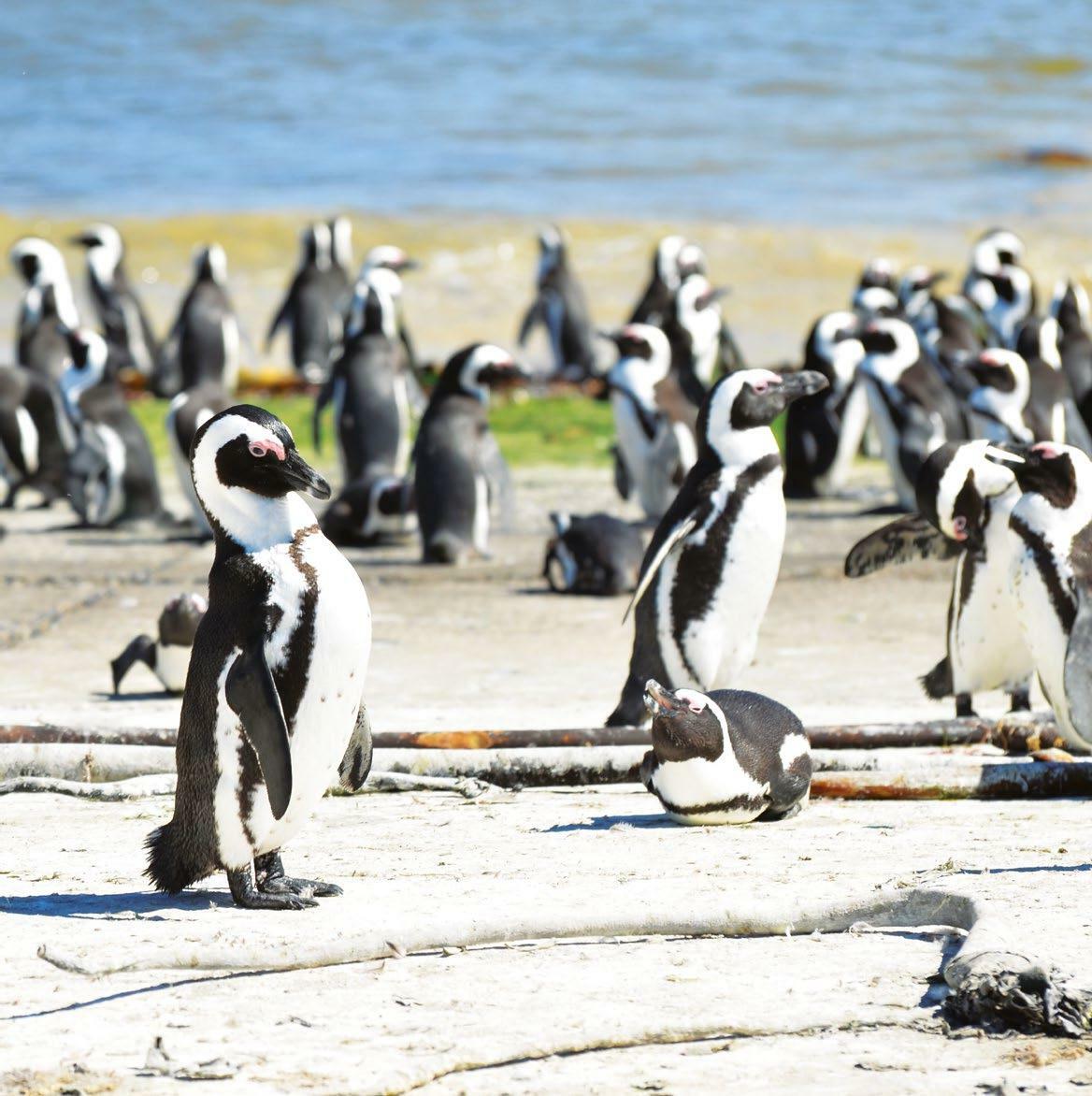

SOUTH AFRICAN GRADUATES MAY BE MOSTLY EMPLOYED, BUT SKILLS AND JOBS OFTEN DO NOT MATCH
Labour markets around the world are undergoing significant changes, particularly in non-tech sectors (bit.ly/3nSK0k4). South Africa has not been spared from this wave of change. The country has high unemployment rates by global standards, both at national level and among the youth (bit.ly/3eTaGwJ).
According to some theories, higher education leads to better labour market outcomes and improves future income through better career paths. But these theories have been criticised (bit.ly/3gZlfBb) in countries with high rates of unemployment, where even graduates often

struggle to find employment. It seems higher education is no longer a guarantee of a job (bit.ly/3nKsj60).
In 2019, South Africa had the largest share of mismatched workers (bit.ly/3edzSyW), with skills mismatches of more than 50%, and the lowest productivity levels compared with 30 countries including India and Russia. Other studies have found the incidence of educational mismatch to be similarly high in South Africa. A quarter of the respondents were over-educated and 27% were under-educated for their occupations.
Yet, many students continue to enrol for

qualifications with low employment prospects. According to the 2019 PostSchool Education and Training Monitoring Report (bit.ly/3xLkSA7), between 2010 and 2016, the field of humanities accounted for the biggest share of graduations (6.6%). This was followed by science, engineering and technology, business management and education—with graduation rates of 5.5%, 5.2% and 1.8% respectively.
My research in South Africa (bit.ly/3eg8Ve9) suggests a graduate’s pathway depends on his or her field of study. Studying the relationship between career choice and unemployment length revealed the most important factors affecting graduate unemployment were qualifications and majors. These did not appear to be aligned with labour market requirements. To achieve a better alignment, it is also important to know why students are choosing to study subjects that are not in high demand.
I surveyed a random selection of graduates aged under 35 who were alumni of one
South African university. Most of the respondents had a degree in commerce (53%), followed by humanities (25%) and then science and education (both at 11%). Most, 88.8%, were employed. The career category with the most unemployed respondents (23.1%) was human resources, industrial psychology and
Human resources, industrial psychology, labour relations management, public management, public administration and politics remained the most popular majors. Yet, many graduates in these mainstream subjects had to wait for a long time before finding a job. In particular, the waiting period was longer for graduates who

labour relations. About 15.4% of the unemployed graduates had majored in government or political studies. Another 15.4% had majored in accounting or finance and 11.5% in economics, psychology or sociology.
majored in public management, public administration and politics (about 19 months compared to the 10.5 months for graduates who majored in human resources, industrial psychology and labour relations). Accounting, mathematics, education and
The CBE practices the art of resilience and agility, observes changing workplace expectations, the impact of technology on the world of work and thus reimagines the profile of future graduates and the workforce flourishing in the field of economics and business.

The College houses six schools and twelve departments where all of the CEPs are offered. CEPs include institution-approved short learning programmes and whole programmes that may be credit or non-credit bearing.
There are currently an estimate of 12 bridging programmes, 10 whole programmes and 148 short learning programmes available of which; eight new programmes and 15 focused on 4IR. Fifty five of these programmes have a strong techno-enablement and empowerment focus.
For more information (General Enquiries - your first point of contact)
Email AskCBE@uj.ac.za Tel +27 11 559 4586 | +27 11 559 2492 Website www.uj.ac.za/cbe
The School is highly rated on a national level as well as on the African continent. It continuously builds on best practices to improve governance, public policy and management capacity.
On offer are study opportunities ranging from certificates, undergraduate degrees, an advanced diploma, honours, master’s and PhD degrees in public management, service delivery, policy development, leadership, good governance, sustainable development, regional economic development and the Fourth Industrial Revolution (4IR). We pride ourselves in preparing well-balanced graduates ready for work with welldeveloped soft skills, including critical analysis and problem-solving skills, within a fastchanging environment.
For more information
Email AskCBE@uj.ac.za Website https://www.uj.ac.za/faculties/cbe/Public-Management-and-Governance
"Develops critical thinkers and problem solvers who address business, economic and societal challenges”
health graduates had the shortest average waiting periods.
Those majoring in mathematics, statistics and engineering took about seven months less to find a job than human resources and labour relations studies graduates. The latter group were unemployed for an average of 10.5 months. Accounting and financial management (maths-related) graduates took about three months after graduation to find a job—so did those who majored in language and communication.
Of the graduates who were employed, more than 70% were employed in a job relevant to their field of study, while around 27% were in jobs that did not relate directly to their studies. About half of the latter indicated they were in a job requiring lower skills than those they had acquired during their studies—for example, a graduate with an accounting degree working as a cashier.
Of those who were unemployed, 80.8% were black graduates and only 19.2% white. And more than two-thirds of the respondents with humanities degrees were black.
The choice to study a particular discipline is affected by many factors (bit. ly/3tiaU5G), most of which are beyond the control of students: such as family background, schooling, race, higher
education institution, employer perceptions and many others.
The mismatches between educational achievements and job requirements give rise to under-employment (bit.ly/3tePfM0), where an individual is employed in a job that is lower by some standard, be it working hours, income, or skills and qualifications.
These mismatches and skills shortages have been pervasive. Some studies point to them as systemic (bit.ly/3vGOBIM) and connected to many factors (bit.ly/3xVf8Ea). These structural aspects are still prevalent more than two decades after the end of racial segregation in the country.
There is a need to understand why
students continue enrolling in non-critical courses. The focus needs to shift from skills demand to skills supply. The Labour Market Intelligence Partnerships Project (bit. ly/3aXGAHy) already indicates what employers want.
A focus on the supply side of the youth labour market, starting with the basic education curriculum, will ensure graduates are adequately skilled to meet the needs of the labour market. Otherwise, mismatches will continue to rise and be masked by increased access to higher education and low graduate unemployment rates. ◆

LEARNERS SIMPLY HAVE NO INCENTIVE TO KEEP AT THEIR STUDIES WITHOUT PEER PRESSURE, A TEACHER AT HAND OR A STRUCTURED LEARNING ENVIRONMENT.
Imagine living on one of the country’s top-rated golf courses! Make Arabella your home and enjoy limitless access to an 18-hole championship course with pristine greens – banked by SA’s largest fresh water lagoon. Experience impeccable views and a breathtaking setting, where birdies and eagles are beckoning. To find out more, visit our website today.


Many African countries had a surprise manufacturing surge in 2010s—it bodes well for the years ahead
The COVID-19 pandemic has wreaked havoc on the global economy, with world output contracting at 3.5% in 2020 (bit.ly/3tqhN5n), and no recovery likely before the fourth quarter of 2021. Similar to other developing regions, sub-Saharan Africa recorded a 2.6% decline—following strong growth of 3.2% in 2019 (bit.ly/3eQzRjx).
Unfortunately, this comes at a time when the region has been experiencing a surprising and very welcome manufacturing renaissance. Historically, industrialisation has been associated with rapid technological improvements and sustained growth in the western world, and more recently East Asia—gainfully employing millions of workers and helping it to close the income gap with richer countries.
Until the 2000s, sub-Saharan Africa
was actually de-industrialising: The mood was gloomy as the little manufacturing activity that did exist was disappearing, and with it the traditional route to development and poverty reduction. In northern Nigeria’s biggest city, Kano, for example, textile factories, leather tanneries and ceramics plants were visibly falling into disrepair (econ.st/2RosoQC). There were reports of empty industrial parks in Ethiopia (econ. st/3nWOCWt), while South Africa’s footwear
industry had collapsed.
But recently the trend has reversed across the region. We have documented this in new research (bit.ly/3udJ2B8) based on an in-depth investigation of national statistics in 51 countries, including 18 in sub-Saharan Africa, ranging from South Africa to Ethiopia to Nigeria to Kenya to Mauritius. These 18 countries account for nearly three-quarters of the gross domestic product of the region (bit.ly/3eR09lP), so they are a

SMALLER FIRMS HAVE BEEN MAINLY RESPONSIBLE FOR SUB-SAHARAN AFRICA’S INDUSTRIAL RESURGENCE
good representation of the overall picture. The graph opposite shows how this industrial renaissance affected the share of manufacturing employment in three of the countries in the study, namely Nigeria, Ghana and Rwanda. Manufacturing in Ghana and Nigeria started to expand from around 2010 onward, while in Rwanda it had been steadily increasing as a share of employment since the 2000s. Rwanda’s industrialisation includes the opening of its first car assembly plant by Volkswagen in 2018, for instance (econ.st/2QTzdK7).

We saw the same broad trends across the region (bit.ly/3vERMjZ), although in some—such as Mauritius—industrial capacity continued to decline. As you can see from the table below, the average percentage of employment in manufacturing in the African countries in our study remained static at 7.2% between 1990 and
Manufacturing as a % of employment, 1990–2018
Source: GGDC/UNU-WIDER Economic Transformation Database

Manufacturing in Africa, Latin America and East Asia
Note that these are unweighted averages
Source: GGDC-UNU WIDER Economic Transformation Database
2010, but had risen to 8.4% by 2018. This is still low in comparison with developing Asia and Latin America, but the trend is clear enough.
Despite this promising trend, another thing to note from the table is that the manufacturing in the region as a share of real value added (in other words, GDP) actually decreased. What this tells us is that productivity growth in manufacturing was lower than in the economy as a whole. In fact, manufacturing productivity barely improved at all in the region in the 2010s.
To explain why manufacturing employment rose while productivity stayed the same, we need to make a distinction between small and large firms. Large modern firms tend to be more productive than smaller firms, partly because they benefit from economies of scale so that more goods can be produced on a larger scale, but with lower input costs.


What seems to have been happening is that smaller firms have been mainly responsible for sub-Saharan Africa’s industrial resurgence, hiring workers (bit.ly/3eg47W4) to make more low-quality goods such as processed food, clothing and wood products to meet rising demand from domestic consumers. This is different to manufacturing in East Asia, which was driven by exports. In sub-Saharan Africa, some manufacturing work moved from China to countries such as Ethiopia in search of lower wages (brook.gs/3edjFdc), but it is debatable to what extent this has driven the overall trend toward increased industrialisation.
One major question that stems from our research is how this trend toward more industrialisation in sub-Saharan Africa is likely to have been affected by COVID-19. Various economic activities have taken
a hit, particularly travel and tourism, as lockdown policies have put a break on commerce and travelling. Fundamental drivers of long-term manufacturing growth have also been held back—especially education, with schools closed in many countries for extended periods.
On the other hand, since the recent manufacturing growth has mainly been serving a domestic and not an export market, it is at least not primarily depending on demand from other countries. But as far as exports are concerned, the initial indications (econ.st/3nMb8Rz) are that commodity exports in sub-Saharan Africa were hit harder than manufacturing— vividly illustratedby the collapse in oil prices in 2020 (which has since bounced back). The recently created African Continental Free Trade Area (au.int/en/cfta) may also boost regional trade in manufactured goods in the years to come. So, all in all, the manufacturing renaissance in the region may be relatively resilient.
As Arthur Lewis, a Nobel-prize winning economist from St Lucia, noted back in 1979 (bit.ly/3uiwloN), expanding small-scale activity in manufacturing is an important part of the development process. In sub-Saharan Africa, this has been made possible by an expanding market for domestic produce. Assuming the pandemic has not undermined this too badly, there is no reason this trend should not continue in the decade to come. ◆
Gaaitzen de Vries
Associate Professor: Global Economics and Management University of Groningen
Emmanuel B. Mensah
Postdoctoral Researcher: Development Economics University of Groningen
Hagen Kruse
PhD Researcher: Development Economics University of Groningen
Kunal Sen
Director: World Institute for Development Economics Research United Nations University



Higher quality seeds could help beat Africa’s ‘hunger pandemic’

Vaccination efforts across the globe encourage hope of an imminent end to the COVID-19 health crisis. But the food security crisis that the pandemic has deepened cannot be alleviated quickly and will require lasting solutions (bit.ly/3vT8LiX).
Well-adapted and nutrient-dense crops like millet, sorghum, groundnut, chickpea, pigeonpea, cowpea and common bean— collectively called dryland cereals and legumes—are like a vaccine of sorts for hunger and under-nutrition (bit.ly/33d30QH). This is because, over time, improved varieties of crops will be able to render farming resilient to climate stresses, help improve nutritional outcomes and improve soil health. In the short run, they boost yields, ensure food sufficiency in
farm households and increase earnings (bit.ly/3vLIR0t).
Even before the COVID-19 pandemic, seed systems, which determine seed access in a country or a region, were beset with challenges. In a paper published last year (bit.ly/33hwwEI), we identify what the bottlenecks are and what can be done about them.

The biggest issues we identified include, firstly, the limited access to varieties of groundnut, chickpea, pigeonpea, sorghum and finger millet that are bred to perform where they are needed. They need to be suited to changes in temperature and rainfall in the area and the stress of pests and diseases. They must also be nutrient-dense and there must be a market for them. The problem of access to these varieties is partly due to limited interest in the private seed
sector to include grain legumes and dryland cereal crops in their portfolio.
The second issue is the limited capacity of the institutions involved in the production and delivery of early generation and certified seed production.
Thirdly, there are large gaps in the flow of information, which means farmers have limited awareness of crops best suited for their environment and the merits of new varieties.
The pandemic further hit these systems, warranting emergency responses from governments and relief agencies. To ensure quality seed flow in the long run, several interventions have been identified.
One useful intervention would be to organise farming communities, or seed
producer groups, into business entities. This would offer several benefits. Primarily, it would help boost local access by people who currently cannot get or afford certified seed.
High-quality seed access will mean better quality grain production and meeting the standards set by grain buyers. This, in turn, would enhance grain demand and encourage farmers and other seed enterprises to produce and use quality seed.
Another problem that needs to be addressed is quality control. Farmers in Africa often procure seed from informal markets, which does not allow for robust quality checks. In a sample of 2 592 smallholder farmers in six countries, 92% of sorghum seed, 84% of millet seed, 93% of groundnut seed, 93% of common bean seed and 88% of cowpea seed were reported to be from informal sources (bit.ly/3eSD8yX). These seeds are likely to be suboptimal. They are more likely to be of subpar genetic purity, unknown variety and hence performance—and they may have a huge seed-borne disease burden.
Another challenge is how information is shared, and what language is used. For example, a study in Uganda (bit.ly/3nN36YL) found that farmers were interested in and willing to pay for high-quality seed. But the term ‘certified seed’ did not strike a chord with them. The research concluded that simpler language, such as ‘super seed’, would be better.
A major hurdle is getting seed companies to participate in developing the new varieties. This could be through using structures like the Seed Revolving Funds (bit.ly/3nNreKB). These involve an initial startup fund to get groups of seed producing farmers to produce foundation seed from breeder seeds sourced from research institutes that are later multiplied into certified seed for sale to the larger farming community. The sale of proceeds of foundation seed supports the scheme by covering infrastructure costs and packaging. The fund has had success in Malawi
(bit.ly/2PM2k1w) and is being piloted in Tanzania.
Through the work (bit.ly/3tiCvni) of the International Crops Research Institute for the Semi-Arid Tropics and partners in Africa, there is evidence that local seed production can benefit immensely from communities setting up and managing seed banks with support and technical backup from agriculture research organisations. Seed banks are local stocks of seeds managed by a community of farmers who have been trained in seed production, harvest and post-harvest management. They may also involve private-sector collaboration (bit.ly/3xJShv8).
An example of how crop researchers can help is by calculating for farmers how much seed they would need per unit of land for maximum yields and growth efficiency. This planting data is essential for smallholder farmers in particular. These measures have already been tried in Ethiopia, Kenya and Tanzania. This has led to a 30% increase in the adoption of improved varieties.
Finally, digital tools such as digital seed catalogue (seedsystems.icrisat.org) and road map applications like SeedX (seedx.icrisat.org) and social media have to be added. They are increasingly popular and available.
We believe the fallout from COVID-19 has presented an opportunity that should be exploited. This is because some people have taken refuge in agriculture after losing their jobs to the pandemic.
Newcomers from formal employment sectors are more likely to be willing to take professional planting advice, adopt improved varieties and use high-quality seeds. This is an opportunity to intervene on behalf of nutrition.
Increasing the likelihood of good harvests and good returns in the near future will ensure African farms can sustain and help reverse rural-urban migration. More hands will mean increased food supply to meet the demands of a growing population and an opportunity to make diets nutritious.

For governments, policymakers, research institutions and others wanting to intervene in African food systems to help fulfil this long but connected chain of objectives, the time is now. ◆
Chris O. Ojiewo Theme Leader: Seed Systems CGIAR System OrganizationFARMERS IN AFRICA OFTEN PROCURE SEED FROM INFORMAL MARKETS, WHICH DOES NOT ALLOW FOR ROBUST QUALITY CHECKS.






